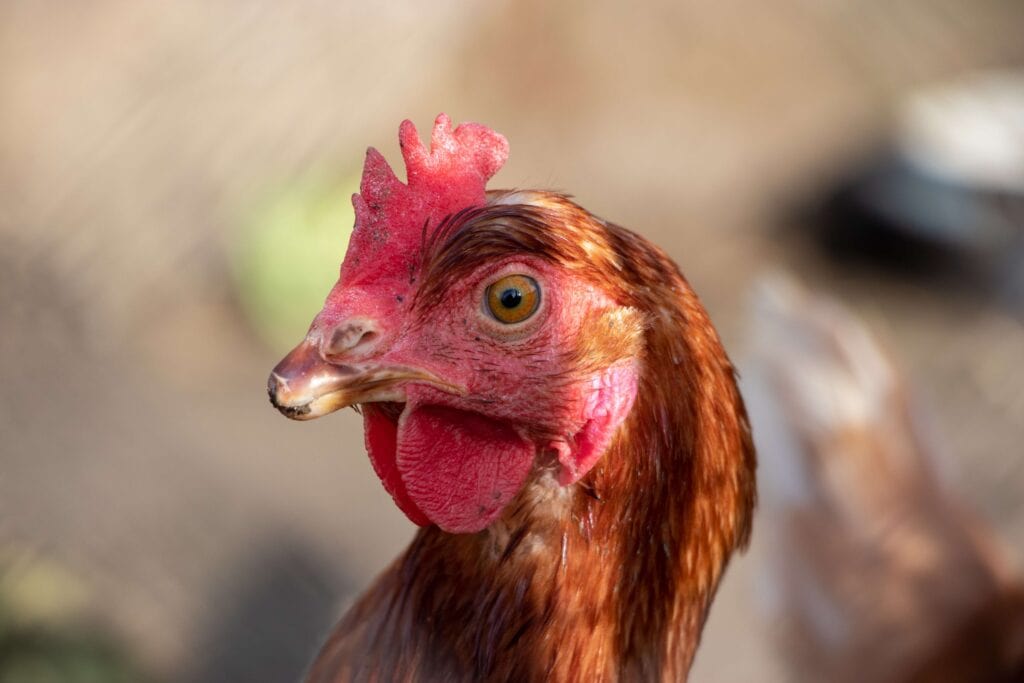Like the absolute majority of birds, chickens love to perch. It’s one of the strongest natural instincts they have, and something that makes them feel safe, while also providing comfort and stimulation. But while wild birds will have to do with branches, telephone wires and garden chairs, you should make sure your flock have perches that are made especially for chicken feet, to make sure they stay happy and healthy both day and night. Read on to get all your perching questions answered!
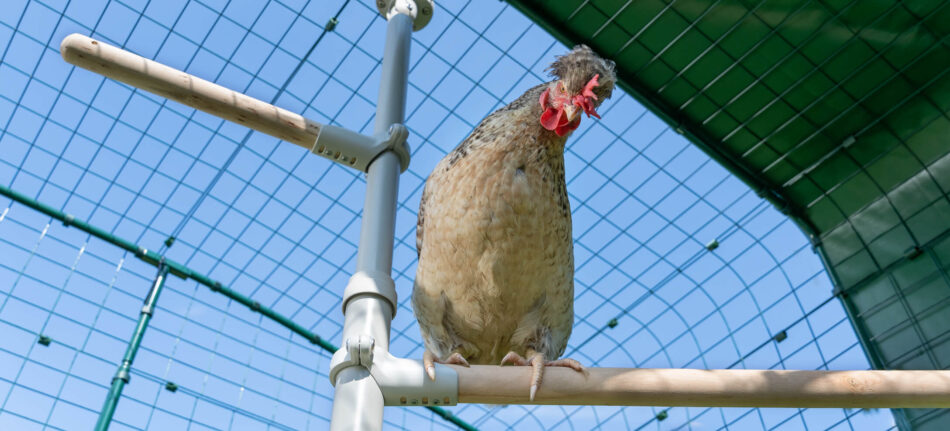
Why do chickens need perches?
Perching is one of the strong instincts that domesticated chickens still very much have, and you will find chickens, just like all other birds, seeking out places off the ground to sit and relax.
Having a perch means hens feel safe while sleeping next to their friends, and it’s important to provide them with this sense of security both inside and outside of their coop. In fact, perching is a recognised welfare need of all birds, and European law insists on perches, even for caged birds.
What shape should a chicken perch have?
This depends slightly on how long the chickens are spending sitting on the perch or roosting bar. Unlike most other birds, chickens sleep with their feet resting flat, and a handy locking mechanism curls only the toes around the perch so they don’t fall off when drifting off to sleep.
When chickens settle in for the night they rest their keel bones (the bone on the breast) on the perch as well as their feet, which spreads the pressure from the birds’ weight. If the perch is sharp or very bumpy, this can put the pressure balance off which can lead to sores on the feet, and rubbing the keel bone against an uneven, rough surface can irritate the skin. That’s why it’s best to have a flat, smooth perch for roosting.
Perches put on the chicken run or elsewhere in the garden that are not specifically used for sleeping, but rather as somewhere the bird can sit for a quick nap or to see what is going on around them, can be rounder and rougher. This is simply because the chickens won’t spend as long on them in one sitting. You can put up some branches for your flock to rest on, but if you want something custom made the Omlet Chicken Perch can be attached at any height, to any surface, and is the perfect size for the absolute majority of hens.
How much perch space should each chicken have?
You should calculate 20-25cm perch space per bird, but large birds might require a bit more, and bantams less, so it depends a bit on the flock. At night, especially in winter, you will find that the chickens huddle together into one feathery ball to help each other stay warm, but to prevent aggressive behaviour, and to keep your flock cool in warmer weather, it’s important to give each bird enough perching space.
How thick should a chicken perch be?
The ideal perch size varies slightly depending on what breed of chicken you have, but somewhere between 2cm and 5cm suits most hens. For roosting bars, don’t go wider than around 8cm, as the birds will then struggle to grip the perch with their back toes, and can find it hard to keep their balance while sleeping.
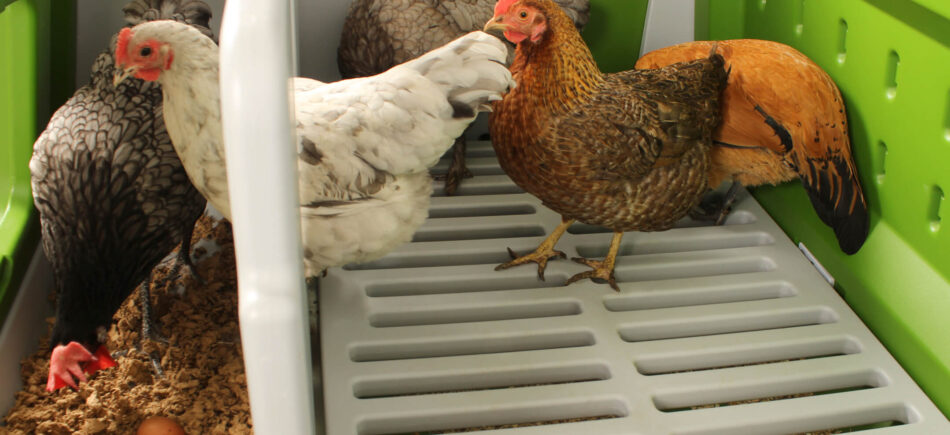
What material should a chicken perch be made of?
The important thing here is to assure that the perch will be safe to touch in all temperatures, and that the perch is smooth but still has grip. For example, chickens’ feet can literally freeze to a metal perch in the depths of winter, and some plastic materials run the risk of cracking in the cold and melting in the heat.
Strong, untreated wood is the most common material for chicken roosting bars, such as eucalyptus, the material used for the perches of Omlet’s Chicken PoleTree. A good quality plastic that isn’t too slippery has the added benefit of being very easy to wipe clean. The roosting bars in the Eglu Chicken Coops have a structured pattern on top of the flat bar with rounded edges, which provides grip and stability.
How high should roosting bars be placed?
You often hear that wild chickens perch high up in trees, and it’s natural to think that would be the dream scenario for your flock as well. But domesticated backyard chickens of today are far from the wild jungle fowl they descend from, and although they like perching off the ground, most don’t need to be particularly high, especially not while sleeping.
In fact, keeping perches too far off the ground can increase the risk of injuries when the hens jump down from the bars, especially risky for elderly or recently rescued hens. So as long as they have something to grip, and aren’t sitting on the unsanitary floor of the coop, most birds will be happy.
Should chicks have perches?
Yes. Chicks start exploring their surroundings and jumping onto higher surfaces from the age of three days, so even though they most likely won’t roost on the perches, it’s a good idea to provide them with something to perch on early on to get them used to it. It’s also good for their bones, and teaches them how to safely hold onto a perch.
With this being said, don’t provide your chicks with high perches, as you don’t want them to jump before their bones have properly formed. Start with something on the floor, and raise gradually as the chicks grow.
This entry was posted in Chickens
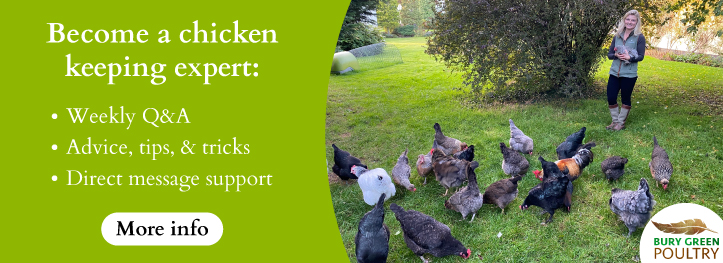
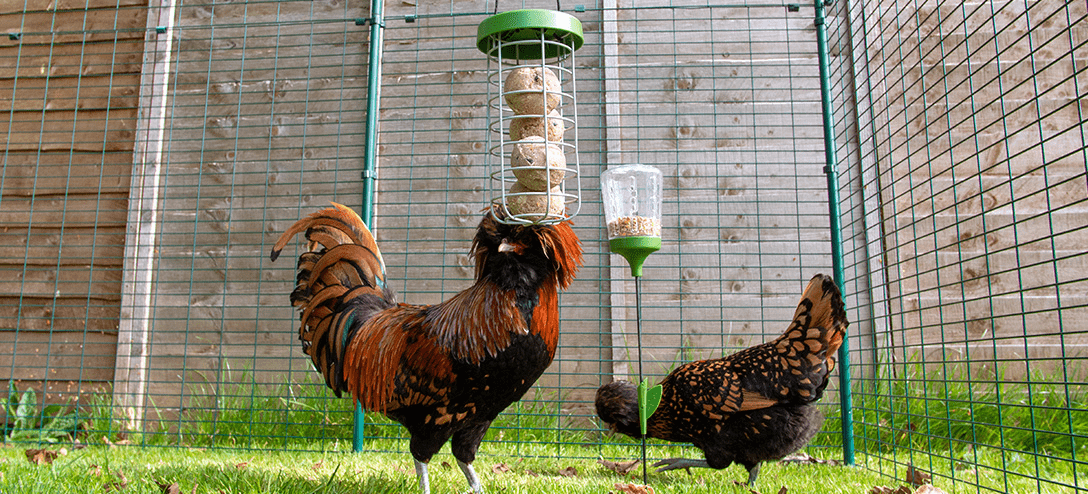
Are you considering incubating some of your chicken’s eggs? Or maybe you’ve even already welcomed in some newly-hatched chicks and have been left wondering how exactly you can tell a cockerel from a hen?!
Whilst both are chickens, a cockerel, also known as a rooster depending on where you’re from, is a male, and a hen is a female. When it comes to chicks, you may be familiar with the term ‘pullet’, which is the name given to a hen who is from the current year’s breeding. You may find it useful to take a look at the Omlet Chicken Glossary and our blog on how to tell the age of your chickens to find out some further information on this subject.
So, now we have established what both are, we can look into what the physical and behavioural differences are between them. It’s worth noting that most of these differences won’t be immediately identifiable upon hatching, and may slightly vary from breed to breed. However, later in this blog we’ll look more at the weekly development of chicks, and at which stage you will be able to tell the differences between the sexes.
5 Easy Ways to Tell Physical Difference Between a Cockerel and a Hen
Hackle Feathers
When we look at determining the sex of a chicken, this is called sexing. One way to do this is by looking at their feathers, their hackle feathers in particular. Hackle feathers are the type of feathers that you’ll find around a chicken’s neck, with the appearance differing between males and females. Something you’ll notice is that male chickens have long, pointy, and thin hackles, which stand up. This is so that they can make themselves appear bigger when they are facing an opponent. Female hackles, on the other hand, are smaller, rounder, and softer.
Do They Have a Cockerel Tail?
Looking at the tail feathers of your birds is another way to distinguish between a male and female chicken.
Saddle feathers are a type of tail feather, which extend on from a chicken’s back and actually sit in front of the tail. Whilst both hens and cockerels have saddle feathers, with female chickens, these are rounder than the saddle feathers of male chickens, which are not only longer, but also more pointed.
Next we have sickle feathers, which hens do not have. These are the long, arched feathers which you find sticking out from a rooster’s tail.
Feet and Legs
Roosters tend to have sturdier, thicker legs, which are actually to serve the purpose of fighting when they need to defend their flock. We’ll look at behavioural differences more later on in the blog.
Spur growth, a part of the leg bone which resembles a horn, could also be another indication of whether you have a rooster or a hen. These are found on the back of chickens’ feet, and whilst not exclusively being a physical attribute of male chickens, these are a lot more common to find on roosters as opposed to hens. The spurs on a male chicken can be inches long and are sharper than those you’d see on a female, should she have any growth at all.
Combs and Wattles
Hens and roosters both have combs and wattles, with the comb being located at the top of a chicken’s head, and the wattles hanging below their chin. The appearance of a chicken’s comb and wattle will differ between breeds, however generally speaking, you can sex a chick by looking at their comb. This is because whilst hens and roosters have red combs, a hen’s comb is not as bright or large as a rooster’s, which is vibrant and will feel waxy to touch.
When it comes to wattles, hens’ are smaller in size than the wattle you’ll see on a rooster. Just as the comb, a rooster’s wattle will also be brighter in colour than a hen’s.
Are They Laying Eggs?
Egg laying is one sure way to know whether you have a male or female chicken! If you notice that your chicken is laying eggs, regardless of whether their other physical or behavioural traits have said otherwise, then your chicken is most definitely a hen!
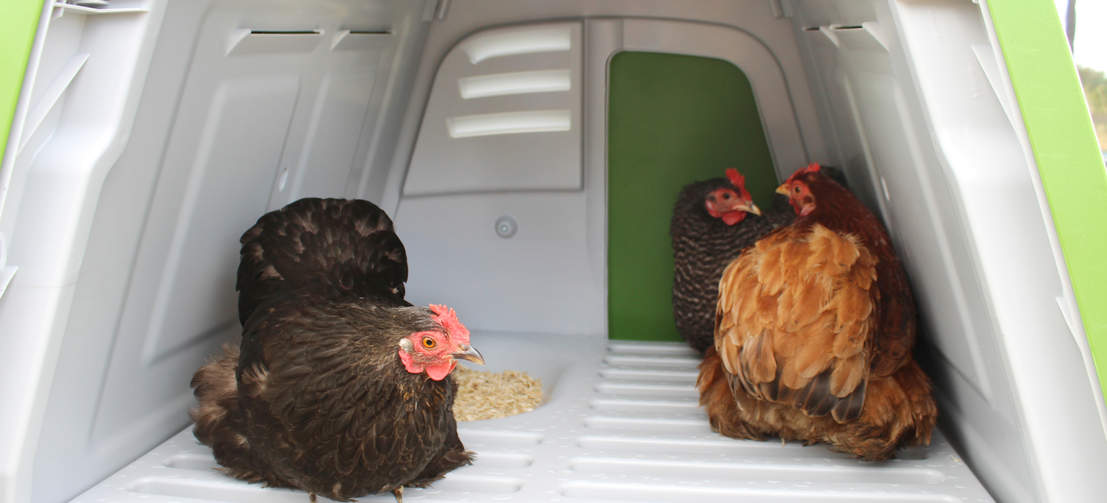
What are the Behavioural Differences Between a Hen and a Cockerel?
Cockerel vs. Hen Behaviour
We’ve looked at the physical difference between hens and cockerels, but what are the different behavioural traits that will help you to sex your chickens?
One big difference when looking at how to tell a cockerel from a hen is with vocalisations, or how your chickens communicate via the sounds they make. Cockerels are notorious for their usually very noisy cock-a-doodle-doo crow! They begin to crow at around five months old, or when they have matured, and do so for a number of reasons. This can be to announce their dominant presence, to mark their territory, or even as a mating ritual.
Whilst it’s definitely not impossible for a hen to crow, it’s a lot less common, and should they do so, it’s often a lot quieter as well. If a female chicken does begin to crow, this is usually because they are at top of the pecking order or will occur in the absence of a rooster in the flock when you previously had one.
You may also notice differences in the levels of aggression between cockerels and hens. Unfortunately, bullying amongst chickens is not that uncommon and can happen for a multitude of reasons. Whilst this behaviour is not exclusive to male chickens, roosters are said to always have an eye out for danger, ready to fight to protect their flock. Usually being top of the pecking order, roosters like to assert their dominance by fighting with other roosters to try and show who’s boss! You can read more about aggressive behaviour with cockerels in our previous post. As with the other physical differences pointed out, how aggressive your chickens are can also depend on their breed. Certain breeds such as the Asil, Modern Game, and Old English Game for example, all rank top of the list of some of the least friendly chicken breeds!
From What Age Can You Tell The Difference Between a Hen and a Cockerel?
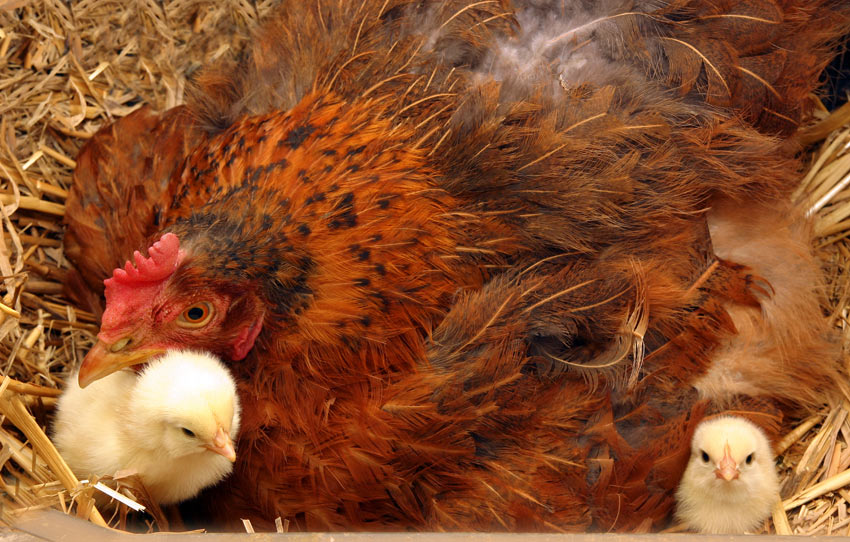
We have now established what the main physical and behavioural differences are between the two, but at which age can we start to tell a cockerel from a hen?
Week 1
For the vast majority of chicken breeds, you will not able to tell their sex from when they have been hatched or even during the first week. The exception to this rule is with auto-sex breeds, who can be sexed just by looking at their colouring within their very first few days. An example of this is the Purebred Cuckoo Maran breed, whereby male chicks usually are an overall lighter colour than females and have a larger and paler spot on their heads than females do.
Similarly, sex links are also an exception. Sex links however, are crossbred chickens as opposed to pure bred auto-sex breeds. In this circumstance, a breeder will mix one specific chicken breed with another to create chicks that will hatch as different colours, based on their sex. This again, will mean that it is possible to be able to tell a rooster from a hen at a very early point i.e. from when they hatch. An example of this is the Red Sex Link, a cross between the Rhode Island Red male with either a White Plymouth Rock, Delaware, Rhode Island White, or Silver Laced Wyandotte female, which produce red hens and white roosters.
Weeks 5-9
Between weeks 5 and 8 in particular, is when chicks start to develop features that will make it easier for you to determine their sex. At this point you’ll notice changes in their physical appearance, such as with their combs. As we mentioned, male chickens generally have a redder comb, and it is at this stage where this will begin to show. This being said, at this stage this is not always an entirely accurate method of sexing.
Another physical difference when it comes to how to tell the difference between a cockerel and a hen during these weeks is the legs of male chicks will likely start looking chunkier than females’.
When looking at rooster vs hen behaviour between these weeks, you may also notice that male chicks will begin ‘strutting’ i.e. standing up straight, walking in an exaggerated manner, and sticking their chest out.
Weeks 10-15
At this point, your chicks will be well into their ‘teenage’ stage, where they’ll be going through some big developmental changes. If your chicks have now reached 12 weeks, they’ll also be ready to move into their Eglu Go Chicken Coop. It will be helpful to go over theOmlet guide on common mistakes that are often made when it comes to raising chicks of this age as well as taking a read of our blog How Long Can Chicken Eggs Stay in the Coop?
In regard to the differences between male and female chicks during these pivotal weeks, it is around week 12 when the pointy hackle feathers (adult neck feathers) will really begin to stand out on roosters. The same goes for the growth of sickle feathers for male chicks, which even at full maturity, hens do not have.
Whilst crowing can begin at a slightly earlier stage, it is usually around the 12 week mark as well when a chicken first does so. Crowing is a behaviour that is generally more associated with male chickens, however as pointed out, this can occasionally happen for hens too.
Additionally, you may notice your female chick beginning to squat. Although most hens will not begin laying until the next coming weeks, this behaviour indicates that she could be getting ready to lay soon, but not just yet!
Weeks 16-20
Now that we’re at weeks 16 to 20 your chickens will be maturing into adulthood! If you have struggled to establish the sex of your chicken by this point, you’ll definitely know, should your chicken start laying eggs between these weeks. This is the most failproof way of determining the sex of your chicken!
Can Hens Turn Into Cockerels?
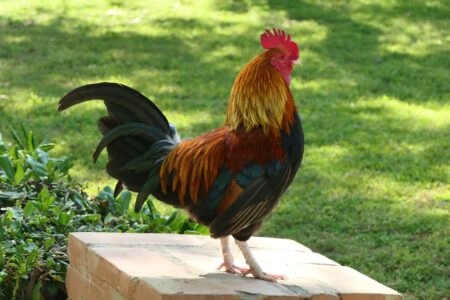 As bizarre as this question may sound, there have been a number of documented cases of chicken keepers claiming that their chickens have changed sex! From the offset, the answer to this question is no – hens most definitely cannot genetically turn into cockerels, nor can cockerels turn into hens.
As bizarre as this question may sound, there have been a number of documented cases of chicken keepers claiming that their chickens have changed sex! From the offset, the answer to this question is no – hens most definitely cannot genetically turn into cockerels, nor can cockerels turn into hens.
However, what can occur in very rare circumstances, is when a hen takes on the characteristics of a cockerel as a result of complications with her ovaries. Hens are born with two ovaries – the left organ is responsible for producing eggs and estrogen, whilst the right, on the other hand, becomes dormant when a chick is hatched. Should the female chicken encounter a medical issue such as an ovarian cyst, testosterone levels will begin to rise, and the left ovary can shrink, which causes the development of an avo-testis. At this point, your hen will stop laying eggs and can even take on the appearance of a male chicken such as a more established comb and wattle!
So, now you know all about the differences between a cockerel and a hen! If you’re new to chicken keeping altogether, or you’re considering incubating some of your chicken’s eggs take a look at the Omlet range of Incubation and rearing equipment.
This entry was posted in Chickens
Evie Walker is 11 years old, and has been passionate about hens for half her life. Apart from the birds in her garden, she is also helping thousands of other hens by raising money for the British Hen Welfare Trust. Evie recently brought home six new rescue hens, and has written a diary of the first few weeks with her new friends. Scroll to the end for an interview with Evie about her passion for poultry!
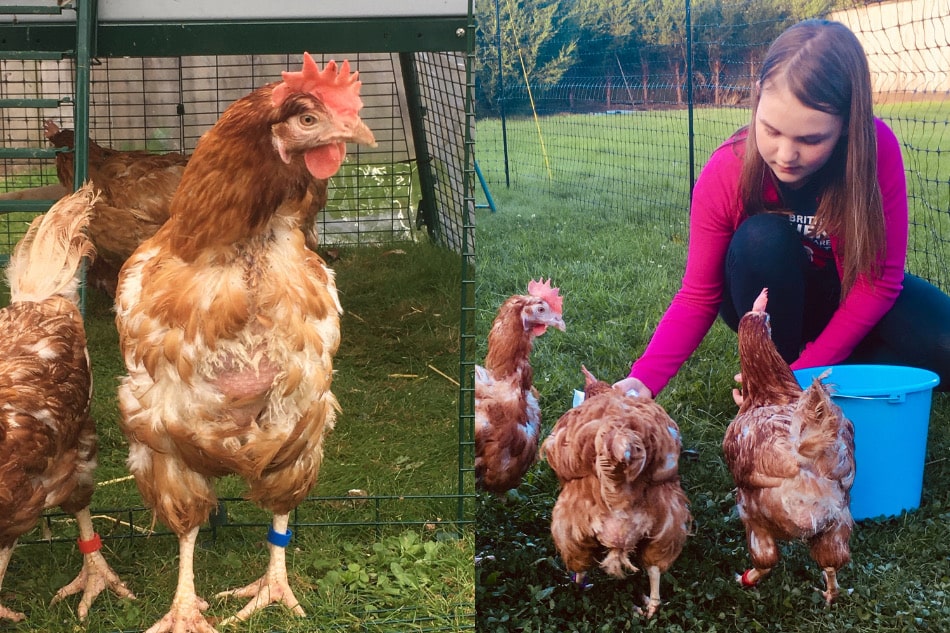
Picking up my new friends
When I heard that there were going to be some chickens who needed a home in our area, we registered on the BHWT website and reserved four hens. When the date of the collection got closer, me and my dad built our new Eglu Cube chicken coop and run and then we put up our Omlet chicken fencing around this so they would have more space outside to explore. We went shopping to buy other things for their arrival; bedding, food, vitamin drops to help them get better, and lots of treats! We also bought them a chicken swing! I also had to start thinking of names for my new pets.
On the morning of the rehoming, we found a big box to bring the hens home in. I made sure I put in lots of straw so that they would be comfy during their journey home. We followed the directions given to us by the BHWT and it was easy to find the rehoming site. When we arrived we were met by some lovely volunteers who asked us if we could possibly squeeze an extra hen or two into our home as they had some “lucky extras” that had come out of the cages.
I was so pleased and happy when my mum said we would take an extra two, meaning we were bring home six lucky hens instead of four! I gave the volunteers some chocolates and a card thanking them for all their hard work, because without their help we wouldn’t be able to adopt the hens.
During the drive home me and my brother made sure we were really quiet so we didn’t scare our new pets. When we got home my mum carefully took them out of the box and put on coloured leg rings so we could easily tell them apart. They were very quiet and stayed in the run attached to the house and didn’t move much. After a little while they started eating – a lot! When it got dark they didn’t know how to climb the little ladder and go to bed in their house so my mum carefully lifted them up into their lovely new home.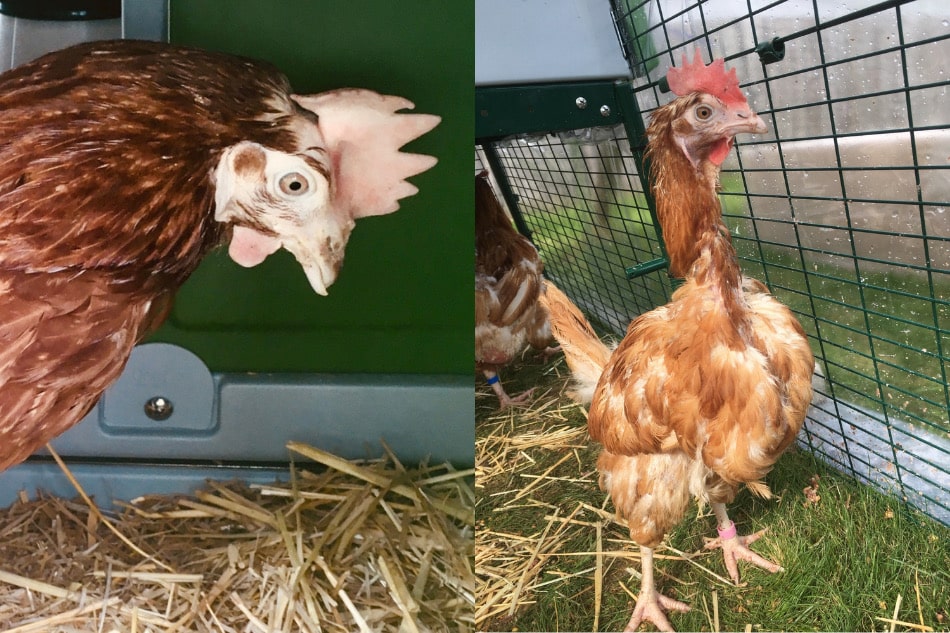
The first weeks
The next morning they needed to be lifted back out of the house as they were unsure of what to do. They stayed in the run attached to their house for the first couple of days but on day three they felt confident enough to go into the larger enclosure; they quickly learned to scratch the ground and loved to lie down and sunbathe when the sun came out. To begin with they were also very scared of us and wouldn’t want to eat from our hands. After sitting quietly with them each day and offering them lots of treats they soon learnt to trust us and now a couple of them even jump on our laps for hugs!
It has now been a month since we rescued our hens and there is a massive difference between the way they were when we collected them and how they are now. They have grown lots of feathers and look much healthier. When they arrived their combs were and pale and hung to one side but already they are brighter and more upright. They are confident to climb up and down their ladder and they lay their eggs in the cosy nest box instead of randomly around their run.
We get an average of four eggs a day from our six hens and the shells are much harder and darker in colour now. To begin with the shells were pale and very thin so we gave the hens crushed oyster shell everyday to help with improving their shells. They love to dust bath to take care of themselves and keep clean.
I think they are now loving their new life and doing all the things they are supposed to do!
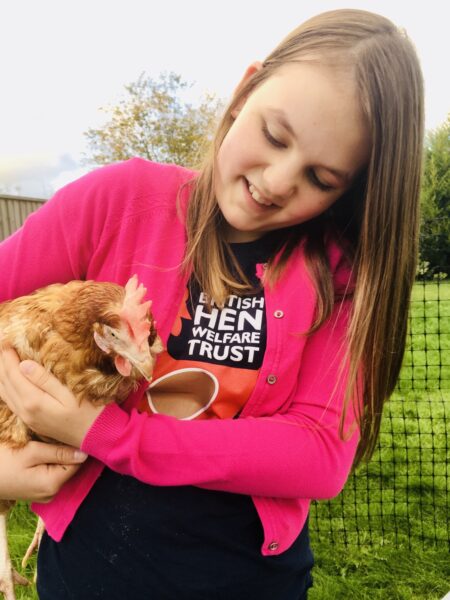
Can you tell us a bit about yourself?
I am 11 years old and have just started secondary school. I have six hens called Skittles, Bellachix Lestrange (I am a massive Harry Potter fan!) Bubbles, Squeak, Hyacinth Clucket and Peggy Mitchell (my mum and dad named the last two!)
I have a 5 year old cockapoo called Daisy who I enjoy walking especially when we go to the beach. In my spare time, I enjoy sewing, knitting, drawing, making things and painting. My favourite thing to do is baking cakes and treats – using eggs from my hens!
When did you start getting interested in chickens?
When I was six, my mum told me about a charity called the British Hen Welfare Trust and how they rescue battery hens when they are no longer needed by the farmer. I thought that I could help to give them a lovely life by caring for them and giving them lots of attention.
Tell us a bit about how you’re raising money for the BHWT.
A few years ago when I first started rehoming hens I decided I wanted to raise money for the charity by selling the eggs laid by my hens and giving all the money to the charity to help other hens still in their cages. Because I enjoy arts and crafts I decided to try and raise a bit more money by painting and decorating wooden hen decorations which I sell on a Facebook page set up by my Mum called ‘Evie’s Pretty Little Hens’. I have also done a few cake sales at school and at my house to help raise more money. So far I have raised over £2000 for the charity!
What are your best tips for people who want to get involved?
The first thing to do would be to visit the BHWT website to see when the re-homings are in your area. You need to make sure you have a safe and secure house for your hens and a nice outdoor space for them to play and explore. My tip would be to read through all the information on the BHWT website so you can be prepared with everything your new hens will need when they arrive.
What is the biggest difference between your old coop and your new Eglu?
Our old hen house, Cluckingham Palace, was built by my Dad out of wood. It was very pretty but hard to clean as I couldn’t hose it out when it got mucky. Wooden houses can also attract mites which my hens once had. After a couple of years the house began to get a few leaks and needed constant repairs. However, with my new Eglu I find it is so much quicker and easier to clean. I can just tip the waste collected on the tray into the bin and then wipe clean the whole house. Every so often I can hose it out to give it a good freshen up. The hens seem to love the cosy nesting area which I fill with hen bedding for them. It’s also really easy to open and shut the door to the Eglu in the mornings and at bedtime.
What are your plans for the future?
I would love to continue to save more battery hens in the future and when I am old enough I would really like to become a rehoming volunteer. Until then I shall continue to help the charity by raising money for them with the sale of my hens eggs and the wooden decorations I make.
This entry was posted in Chickens
This post has been reviewed and updated on Wednesday 2nd November 2022.
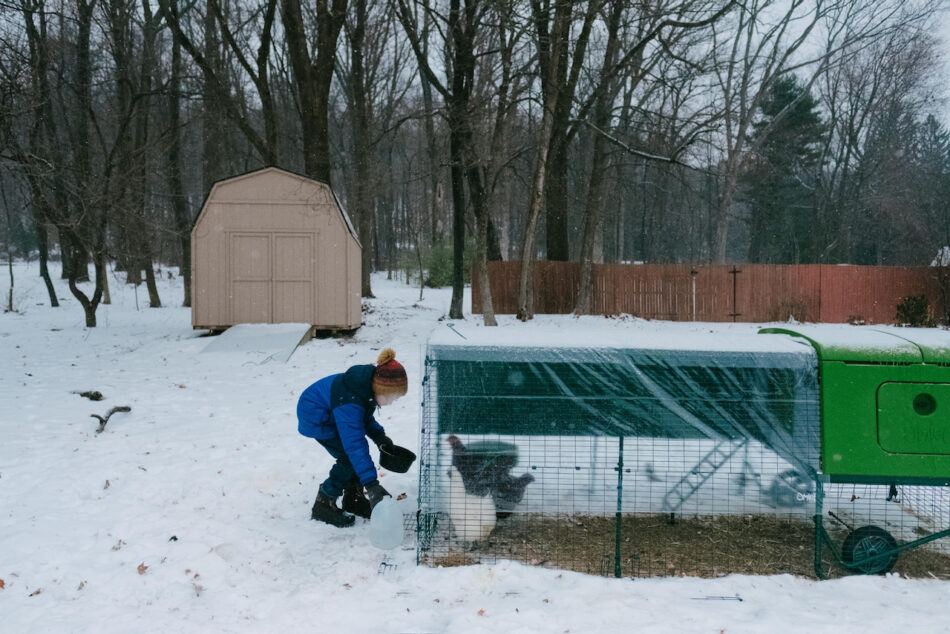
Autumn and winter can be amazing seasons to be a chicken keeper, but while you don’t have to worry about red mites and other heat loving pests to the same extent, the colder months pose other challenges. Besides making sure your chickens are warm and dry, the risk of avian flu increases in the winter months, and you will need to take precautions to make sure your hens stay fit and happy.
We have teamed up with the Department for Environment, Food and Rural Affairs (Defra) to give you a comprehensive guide of what you as a backyard chicken keeper can do to help minimise the spread of bird flu and keep chickens across the country healthy, including some FAQs.
What is Avian Flu?
Avian flu, or bird flu, is a type of influenza that spreads among birds. The virus is not specific to chickens and poultry, any bird can get infected, including wild birds such as birds of prey, geese, and different types of gulls. Avian influenza viruses are classified according to their ability to cause severe disease (pathogenicity) in birds as either highly pathogenic or low pathogenic. Highly pathogenic avian influenza viruses (HPAI) can cause severe disease in susceptible birds and low pathogenic avian influenza viruses (LPAI) generally cause mild disease or no disease at all.
Signs of avian flu in chickens
Chickens with avian flu may display various clinical signs. They may be less active than usual, will lose their appetite and show abnormal nervous signs like head tremors, lack of coordination, or circling. Affected birds will have a drop in egg production and show breathing difficulty with open beaks and runny eyes. Eventually their combs and wattles will become swollen with a blue discolouration.
In most instances however, birds affected with high pathogenic avian influenza will just be found dead with no other prior indications of being ill. Poultry affected with low pathogenic strains of avian influenza may show signs of coughing, sneezing (snicking) and often get green diarrhoea. Unfortunately, many of these bird flu signs are not specific and can be associated with other poultry ailments. So if you have any doubts, please contact your vet for advice.
It can take several weeks for an avian flu outbreak to spread throughout a flock. Some infected birds may exhibit no clinical signs but are still potential virus carriers and can spread it to other birds. Others may get very ill and die very quickly.
Avian Influenza is a notifiable disease, which means that if suspected must be reported to the Animal and Plant Health Agency (APHA). You should always speak to your vet if you’re concerned about the health of your hens, but it’s particularly important if there are local outbreaks of bird flu.
What is the latest situation?
So far this autumn/winter avian influenza has been confirmed in commercial poultry at premises in England. Avian influenza has also been found in captive birds in England.
Avian flu can spread by movement of infected birds, from bird-to-bird by contact with contaminated body fluids and faeces, or through contaminated objects and surfaces. Although an avian influenza outbreak can occur at any point in the year, the UK typically faces a seasonal increase in the risk of an avian flu as wild birds start to migrate. Infected migratory birds can then infect wild or kept birds, resulting in local transmission and contamination of the environment e.g., fecal and feather contamination of poultry ranges, and contamination of bedding stored outside. This is why the risk of avian influenza is not solely connected to the presence of infected migratory wild birds.
As of Monday 7th November 2022, the United Kingdom’s Chief Veterinary Officer has agreed to bring in new housing measures across the whole of England to minimise the risk of the avian influenza spreading amongst poultry and captive birds.
The housing measures mean that it is a legal requirement for all bird keepers (whether they have pet birds, commercial flocks or just a few birds in a backyard flock) to keep their birds indoors, and to follow strict biosecurity measures to stop the spreading of the disease.
These new housing measures will regularly be reviewed.
Preventing outbreaks
Biosecurity is an essential defence against diseases such as avian influenza, and is key to limiting the spread of avian influenza in an outbreak.
All bird keepers should make sure they keep up to date on the latest avian influenza guidelines on the gov.uk, gov.scot and gov.wales websites. There you will find details of biosecurity measures you should take as good practice for the health of your birds, as well as details of things you must do due to the Avian Influenza Prevention Zone (AIPZ) being in force across Great . Some examples include:
Keep things clean
- Wash your hands before and after tending to your birds.
- Clean and disinfect your footwear after visiting the hens. Disinfectants get deactivated by mud and other organic matter, so it’s best to wash off any dirt before dipping your boots in a Defra approved disinfectant. Dilute disinfectant to the correct rate in a tub or bucket, at least ankle deep, and cover with a lid when not in use.
- Alternatively, you can have specific chicken keeping footwear that you store in a watertight box next to the entrance to your chickens’ enclosure that you change into before going in to see the hens.
- Limit the number of people and other pets who go to see the birds.
- Clean and disinfect surfaces regularly. If you have a plastic chicken coop like the Eglu Cube, you can be confident you will easily be able to get to all corners of the coop in no time. Also make sure you clean and disinfect any equipment or accessories on a regular basis.
- Consider concreting areas around the entrances to bird accommodation or putting slabs down so it is easier to clean.
- Store bedding and feed safely to minimise the risk of contamination, as well as pests.
Food, water, and wild birds
- Do not feed wild birds in the vicinity of your chickens.
- Use bird scarers to keep wild birds away.
- Clean up any spilled chicken feed to avoid attracting wild birds or rats and mice. Feeders like chicken peck toys will keep the feed off the ground and minimise the risk of uneaten feed being left on the run or in the grass.
- Keep your chickens’ water and feed undercover or on the run to prevent wild birds from accessing it.
- Prevent your free-range hens from accessing ponds or other areas commonly visited by wild waterfowl.
- If you keep other poultry, you should separate ducks and geese from your hens. These species don’t show any signs of disease, but can pass the virus on to chickens.
Prepare for winter and outbreaks in your area
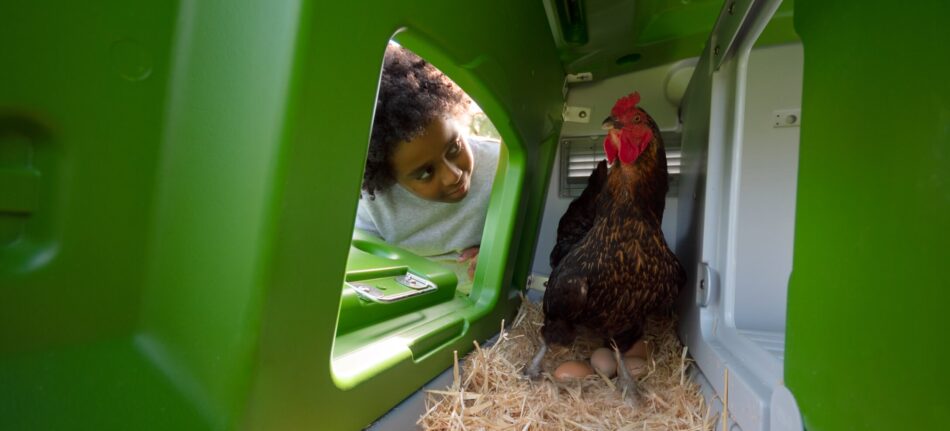
Housing
As of 7th November 2022, housing of all kept birds in England is now a legal requirement to keep them separate from wild birds. It’s important that you have somewhere to keep your birds safe and happy. It should be large enough that all chickens have enough space to carry out their daily activities, safe from predators and wild birds, as well as sheltered from wind and rain.
A coop connected to a large walk-in chicken run is a great solution, but you can also create a DIY temporary home for your flock by adapting any existing buildings you have, such as a shed or a garage. Whichever you choose, make sure to make it as safe and comfortable as possible for your chickens by:
- Checking the roof for leaks
- Clearing the roof and surrounding area of moss and vegetation, which can attract wild birds searching for insects.
- Blocking up holes that could let small wild birds and rodents in or cover with 25mm mesh.
- Ensuring there is good ventilation and natural light.
- Ensuring guttering and drains are clear to prevent flooding.
Keep records
Whether you are selling or just giving to friends and family you must keep records of poultry and egg movements, including dates, quantities and where they were going. A veterinary inspector will ask to see these in the event of an outbreak.
Register your birds
A great way for hobby or pet chicken keepers to stay up to date with the latest avian influenza situation is to register their birds with the Animal and Plant Health Agency. It’s a legal requirement for those with 50 or more birds, but people with smaller flocks can fill out the voluntary registration form on gov.uk.
It’s worthwhile because:
- You will receive text or email alerts if there is a disease outbreak in Great Britain.
- You will receive text or email alerts if you fall within a disease protection or surveillance zone. These are 3km and 10km zones around the infected premises where additional biosecurity is needed.
- By knowing what the disease situation is you can take action to protect your flock.
- By taking action to protect your flock you will also help to protect GB’s poultry industry and the health and welfare of GB poultry.
Frequently asked questions
What is avian influenza?
Avian influenza is a virus that normally affects birds. There are two types of avian influenza virus, highly pathogenic (HPAI) and low pathogenic (LPAI). The highly pathogenic strain is more serious. Low pathogenic avian influenza can mutate into a highly pathogenic strain and therefore swift action must be taken as quickly as possible to stop the disease spreading.
What are the main signs of avian influenza?
With the highly pathogenic strain of avian influenza birds are often just found suddenly dead. However common clinical signs include:
- Lethargy and weakness
- Lack of appetite and not drinking
- Drop in egg production
- Green diarrhoea
- Head tremoring
- Abnormal posture, stance, and movement e.g., circling
- Mouth breathing, gaping
- Sneezing, coughing and snicking
- Blue combs and wattles
- Leg bruising
How does avian influenza spread?
The disease typically spreads through the movement of infected birds, from bird-to-bird direct contact and indirectly via contaminated fluids, faeces, vehicles, clothing, feed, or bedding. Wild birds are also a cause of many outbreaks in kept birds.
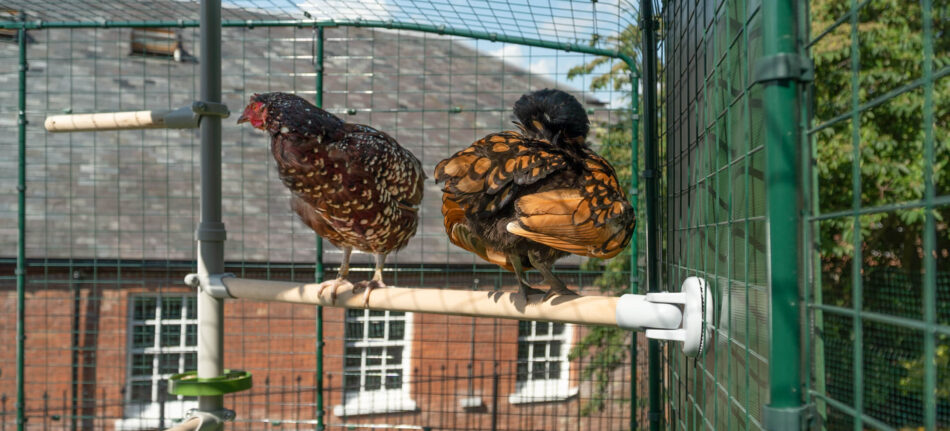
I’m not a poultry farmer and only keep poultry as a hobby or as pets, why do I need to worry about avian influenza?
Between October 2022 and November 2022 there were 85 confirmed avian influenza (HPAI) H5N1 cases in England. Cases have also been confirmed in other parts of Great Britain.
If avian influenza is identified in birds kept as pets or as a hobby, it would still be necessary to put bird movement and trade restrictions in place. This is why it is vital that all poultry keepers, whether you keep hundreds of birds or just a couple of pet chickens, take action to improve biosecurity, to protect both the health of your birds and the livelihoods of poultry farmers in the UK.
When should I start worrying about my chickens having avian influenza, and what should I do if one of them gets it?
If your birds look unwell it’s important to contact your vet. Avian influenza (bird flu) is a notifiable animal disease. If you or your vet suspect any type of avian influenza in poultry or captive birds, you or your vet must report it to the Animal and Plant Health Agency immediately. Failure to do so is an offence.
You can call the Defra Services helpline on 03000 200 301 (England) or 0300 303 8268 (Wales). If you live in Scotland, contact your local field services office.
What does biosecurity mean?
Biosecurity refers to things we do to prevent the introduction and/or spread of harmful organisms (e.g., viruses and bacteria) to animals, people, and plants, to minimise the risk of transmission of infectious disease. Some examples of good biosecurity include washing and disinfecting clothing and footwear before entering your birds’ enclosures and keeping wild bird contamination out.
What is the difference between an Avian Influenza Prevention Zone (AIPZ) and housing measures?
In an AIPZ, additional biosecurity measures are required by law to help protect your birds from avian influenza, and this may require you to house your birds, depending on the risk level at the time. The Government communicate these housing measures to poultry and captive bird keepers if or when they come into force.
Housing measures require you to by law that keep your birds permanently indoors, unless this is completely impracticable (for example if you keep large numbers of ducks or geese, where it may be a welfare issue to keep them inside due to their inability to exhibit natural behaviours). In these instances, alternative measures must be taken. Ducks and geese should be kept in fully netted areas or temporary netted structures, where practical. All feeding and watering should take place under cover.
If housing measures are not in force, an AIPZ will require free-ranging birds to be kept in a fenced area to minimise their contact with wild birds. Other biosecurity measures include keeping your birds’ food and water undercover, cleaning up evidence of wild birds in your birds’ fenced area (for example feathers and faeces), putting netting over ponds and cleansing and disinfecting footwear before and after tending to your birds. However, high standards of biosecurity should be maintained as good practice for the health of your birds even when an AIPZ is not in place.
Full details of the requirements all bird keepers must follow under the AIPZ currently in force across England are available together with biosecurity guidance and information on the latest avian influenza situation are available at:
If housing measures are in force, do I need to keep my hens shut in at all times?
If housing measures are in place then yes, birds must be always kept undercover. This is to protect them from disease.
What type of housing is suitable to house my birds in?
When poultry are housed, they must be completely undercover. You can buy purpose-built poultry houses, or you can make use of existing buildings, such as barns, farm sheds, outbuildings, garages, and garden sheds and adapt these for your birds. Or build a lean-to on the side of an existing structure.
If your housing is too small to permanently house your birds, you could extend it by creating a covered run from tarpaulin or a gazebo and use 25 mm mesh for the sides to prevent small wild birds from getting in. Straw bales can also be used to make a temporary poultry house with a tarpaulin roof.
It is important that your birds have access to natural light and that there is good ventilation. Any openings must be netted with 25mm net to prevent wild birds from gaining access.
If you keep ducks and geese, they must be kept separate from other poultry species as waterfowl often don’t show any signs of disease but can pass the virus on to chickens.
What actions can I take now to protect my birds from avian influenza?
Maintain your birds’ housing by:
- Checking the roof for leaks
- Clearing the roof and surrounding area of moss and vegetation, which can attract wild birds searching for insects.
- Blocking up holes, which could let small wild birds and rodents in, or cover them with 25 mm mesh.
- Ensuring there is good ventilation.
- Ensuring guttering and drains are clear to prevent flooding.
Also:
- Clean and disinfect (using a government approved disinfectant) footwear and equipment before and after tending to your birds, as well as all hard surfaces.
- If you sell any of your chickens or their eggs, keep records of movements.
- Store bedding inside to reduce the risk of contamination.
- Make your premises unattractive to wild birds. Use bird scarers, foils, or streamers.
- Remove any spilled feed regularly and control rats and mice.
- Place your birds’ food and water in fully enclosed areas that are protected from wild birds.
- Put fencing around outdoor areas where birds are allowed and limit their access to ponds or areas visited by wild waterfowl.
- Where possible, avoid keeping ducks and geese with other poultry species.
Do I need to change water/food more than usual if cases of avian influenza are confirmed in the UK?
Food and water should be refreshed/changed regularly for the health and welfare of your birds. To prevent infection with avian flu, the most important thing is that your birds’ food and water cannot be accessed by wild birds. Store food and water undercover away from wild birds. If housing measures are brought in, then your bird’s food and water must be stored indoors. It’s important to clear up spilled feed regularly to avoid attracting mice and rats, as they could spread the avian influenza virus on their feet.
How can I make sure my chickens aren’t in distress when they are confined and can no longer roam free?
If, due to a further increase to the risk avian influenza spread, government bring in mandatory housing measures, warning will be given in order for you to start getting your birds used to being inside before the rule is mandatory.
Once housing measures are in force, ensuring fresh water and appropriate amounts of feed are available and keeping their bedding clean are the main priorities. Chickens spend most of their time awake foraging (i.e. pecking and scratching), therefore, it’s important to provide things that encourage that behaviour. But scatter feeding can encourage vermin, so cat litter trays can be used to scatter food in, or they can be placed under feeders to catch the mess. Other ideas to enrich your birds’ environment include:
- Feeding whole oats, wheat, corn, alfalfa, maize, barley, peas, and carrots, but make dietary changes gradually.
- Mashing feed to increase eating time.
- Adding grit to litter, so birds can scratch and carry out natural foraging behaviours.
- Add different levels, as chickens like to go up high. Try stacking straw bales or adding items of ‘furniture’, such as ladders and swings that they can perch on. Perches can also help avoid overcrowding.
- Hang items to peck at, such as pecking blocks.
- Provide a dust bath.
- Chickens may also enjoy parrot puzzle feeders or even dog puzzle feeders!
- Mirrors can add interest, and moving them around regularly adds more interest.
- Keep surfaces soft, such as wood shavings or sand.
- If you keep ducks or geese, fill troughs or old bathtubs with water to allow preening.
- Play classical music or the radio!
It’s a good idea to vary enrichment regularly, as it otherwise loses its novelty. Be careful about adding new items to the chickens’ enclosure that could be contaminated with the virus, such as leaves or branches from the garden. Contact your vet if you have concerns about the health and welfare of your birds.
How do I get the correct updates regarding guidelines and regulations?
All information you require about avian flu can be found on gov.uk, gov.scot and gov.wales, including information about the relevant legislation.
How can I keep up to date with the latest avian influenza situation?
Gov.uk, Gov.wales and Gov.scot have all the latest information regarding the avian influenza situation in Great Britain.
It is also advisable to register your birds with the Animal and Plant Health Agency (APHA). This is a legal requirement for people who keep 50 or more birds, but if you keep less than 50 birds it’s still worthwhile as:
- You will receive text or email alerts if there is a disease outbreak in Great Britain (GB).
- You will receive text or email alerts if you fall within a disease Protection or Surveillance Zone. These are 3 km and 10 km zones around the infected premises where additional biosecurity is required.
- By knowing what the disease situation is, you can take action to protect your birds.
- By taking action to protect your birds, you will also help to protect GB’s poultry industry and the health and welfare of GB poultry.
This entry was posted in Chickens
Hattie Garlick is a writer and first-time chicken keeper who welcomed two Pekin Bantams into her Norfolk home during the third lockdown. How would they fit into a family life that already included two children, one cat, a goldfish, and a dog of very little brain? Read on to find out…
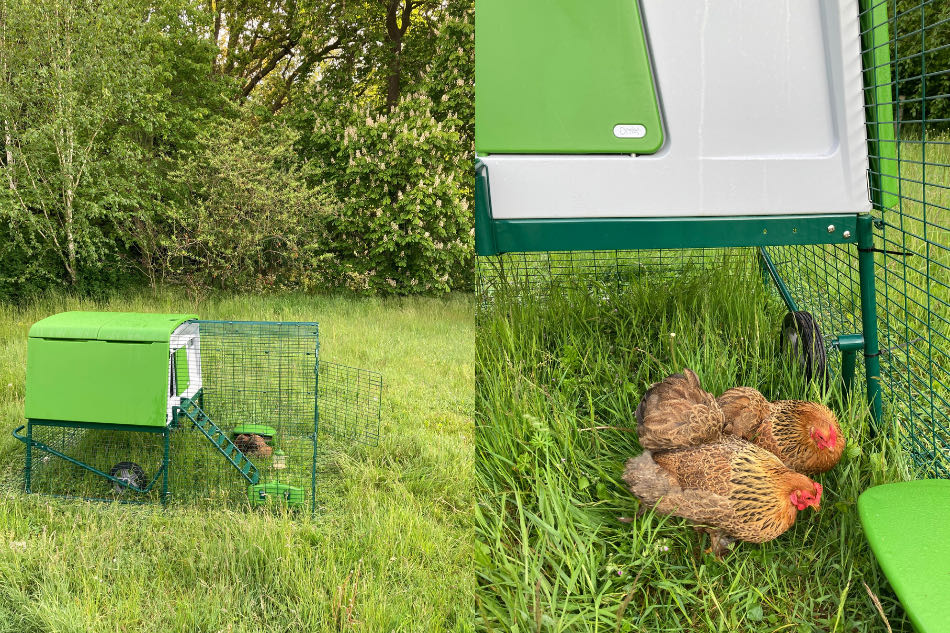
It’s quite likely that, over the past twelve months, you discovered the stress-relieving properties of baking. Across the developed world, Google searches for bread recipes hit an all-time high. While everyone else was finding solace in sourdough, though, my sanity was being saved by soufflé.
Soufflé is a chicken. She and her sister, Einstein, arrived in our garden in the middle of the third lockdown. The children fancied more pets, I drew the line at parrots, and my husband and I thought that hens might at least earn their keep in fresh eggs. That, really, was the extent of their appeal on the day we collected them from a local smallholding. I did not envision then saving me a fortune in therapy bills too.
Yet as the days stretched on, I found myself drawn out of the house, into the garden and standing beside their run. There was, I realised, something gently mesmeric about their movements.
Carri Westgarth, senior lecturer in human-animal interaction at the University of Liverpool, has conducted research to show that watching a dog run is a significant stress reliever. Their unbridled joy rubs off. Watching a chicken potter and peck about is a lot less dramatic. It seems to soften, not sharpen, my emotional state. And during the pandemic, as my nerves frayed and worries jangled, that soft-focus was exactly what I needed.
Maybe I shouldn’t have been so surprised at the girls’ therapeutic influence. Chickens are now widely used as therapy animals in the US and Canada. Here in the UK, a charity called Henpower has introduced hen keeping into more than 40 care homes. A year-long study by Northumbria University found it measurably improved the health and wellbeing of residents while reducing depression and loneliness.
A couple of months after Soufflé and Einstein moved in, I can absolutely understand why. While my daughter thinks they are unimaginably cute, it is harder to anthropomorphise a chicken than a dog or cat. They belong to a whole different animal group to us, after all. They are like the ultimate no-strings relationship: providing the comfort of company without any emotional baggage. Soufflé and Einstein are totally oblivious to my worries about Brexit and R-rates, which are after all totally irrelevant to them. They couldn’t give a cluck.
They need me just enough to propel me into putting my boots on and stomping into the fresh air, first thing in the morning, to open the door of their Eglu Cube chicken coop. This, I’ve discovered gives me a far more positive perspective on the day than my old lockdown routine – slumping in front of the laptop, in pyjamas, till lunch. Beyond that, they really couldn’t care much whether they see me or not. And after months spent listening to the word “muuuuuuuuuuum” bouncing off the walls around the clock, I could not be more thankful to them for this.
We were however, right about one thing when we first decided to bring hens into our home. Fresh eggs in the morning are a real boon at breakfast time. They’re also, however, a great mood-booster in febrile times. It just feels good to reach into the hay and pull out a tiny, tangible, warm-to-the-touch miracle.
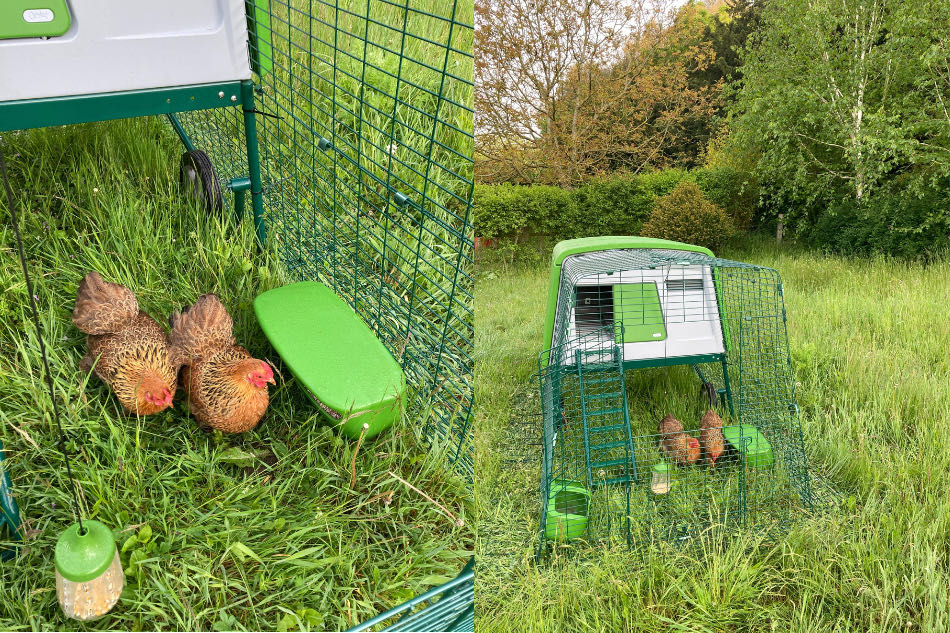
This entry was posted in Chickens

It’s that time of year again when we say goodbye to summer and welcome in the cooler, shorter autumnal days. For many pet owners, summer is a great opportunity to spend quality time with their animals; playing outdoors and enjoying the warmer weather. But, the change in season doesn’t have to mean that the good times have to stop. So whether you’ve got a chicken, guinea pig or are a pet parent to rabbits, here are 8 tips for making their run more fun this autumn.
Why do pets need runs?
It’s important that you continue to keep your pets exercised throughout the year, and animal runs are great for this, giving your furry friends the freedom to roam within a safe and confined environment. Omlet has a range of runs for chickens, rabbit runs and guinea pig runs, which are all predator-resistant, with their innovative mesh designs.
Whilst runs are fantastic for providing your animals with more space, adding a few extras over the next coming months can help to keep both you and your pets entertained.
For guinea pig and rabbit runs
Pig out on veggies
Cavies and rabbits love their fresh veg – you can even make a game of it! Try hiding their favourite pieces of veggies around the run and have them go off to find their treats. This game is the perfect opportunity for you to spend some quality time outside with your pet. Just don’t forget to clean up any remains from the run floor to avoid pesky predators sniffing out the snacks.
Or, use the Omlet Caddi rabbit treat holder or guinea pig treat holder to keep your pets’ brains engaged. Simply fill the treat holders with your rabbit or guinea pig-safe vegetables and watch them spend time navigating how to get them out. Take a look at some suggestions for rabbit treats and guinea pig treats here.
DIY adventure playground
Upgrade your pets’ run to an adventure playground with pet play tunnels. They can simply be attached to your guinea pig or rabbits’ run and provide them with a new way to exercise. Plus, they’ve been designed to mimic the innate burrowing behaviours of rabbits and guinea pigs too.
Shelters can also be a great addition to your run this season. The Omlet Zippi Shelters for rabbits and Zippi Shelters for guinea pigs are weatherproof too, meaning that your pet will be protected from the elements in autumn.
And since both pets have a natural desire to seek a hiding space in a hole, you can be assured that while they’re having fun, they’re feeling safe. The Zippi shelters easily attach to the Omlet play tunnels via connector rings, too, which means you can create a fun maze for your furry friends.
Guinea pig and rabbit toys
Who said toys were just for cats and dogs? Give a new toy to your small animal to help to bust their boredom this season. Toys for guinea pigs and rabbits can simply be hung up in their run and will keep them active, engaged, and curious.
For chicken runs
Make use of those crisp, autumn leaves
The leaves of autumn in your garden can actually be a great source of entertainment for your chickens. All you have to do is build up a pile of crisp autumn leaves in your chickens’ run, and watch them have endless hours of fun pecking. You can even add some sunflower seeds to your pile to have your flock hunt for.
Omlet’s Chicken Swing
Omlet’s Chicken Swing is the perfect way to make your chickens’ run more fun this autumn. The Omlet Chicken Swing will have your chicken in their element, as they get to grips with their new toy. Not only will this run accessory provide them with plenty of entertainment, but you’ll have just as much fun watching them hop on and off and swing back and forth.
Toys for chooks
Chickens can have toys too. A bored chicken can lead to behaviour such as flock bullying and abnormal feather loss, so at this time of year it’s even more important to keep your chickens entertained. Naturally, as the weather drops, these animals get increasingly restless, with less grass and weeds for them to forage on, as they enjoyed over the summer. A chicken peck toy though, is one option to keep your flock happy, providing them with physical and mental stimulation.
Omlet and your pets’ autumn
Omlet knows that this time of year can be more difficult for pet owners but whatever the season brings this year, with Omlet’s range of guinea pig, rabbit and chicken products you and your pets can continue to have fun all autumn long. And, as the end of the season brings colder weather, don’t forget to have a read of the Omlet guides on keeping your guinea pigs, rabbits, and chickens safe and warm when they’re outdoors.
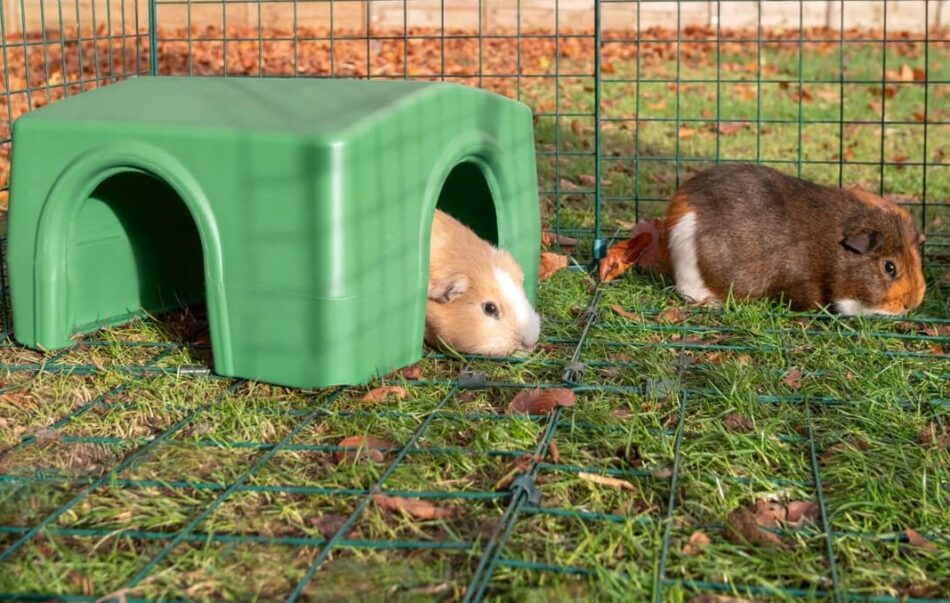
This entry was posted in Chickens


Autumn is a season of change for chickens. They will usually moult at this time of year, which will make them a little uncomfortable when the temperature dips. They will be hungrier than ever while the new feathers sprout, and a few added treats in their diet will be well received. As ever, though, it’s a give-and-take situation when you’re keeping chickens, as the hens will repay your kindness with lots of droppings and soiled bedding, which are great fuel for your autumn compost.
Keeping chickens in the autumn
Autumn is the time for garden bonfires, as the year’s dead vegetation is consigned to the flames. Chickens will head straight for any ashes left over from a bonfire to have a good peck-and-scratch, so make sure these have cooled down before letting the chickens get to work. If anyone nearby is planning a firework or bonfire party, make sure your hens are safely in their coop before the entertainment begins – it’s not much fun at all for a chicken caught in the firework crossfire.
Before lighting those bonfires, check to make sure no chickens have decided to shelter there instead of heading home to the coop. While you’re at it, shoo out any hedgehogs, toads or other wildlife. The base of a cosy woodpile is a tempting place for a small animal to seek shelter from a potential storm!
Not all the garden waste will be burned, of course. Leaves, weeds and leftovers from the vegetable beds can be added to the compost. This is a good time to give your compost heap a good turn with a pitchfork, mixing the soiled hen coop bedding, chicken droppings and other goodies together so that they can work their magic. Only use soiled bedding, as clean sawdust takes a long time to rot down and can, in excess, ‘kill’ the compost.
Cold weather, chicken eggs and chicken feathers
For most hens, egg-laying will still be regular as the season progresses, but there will be a Fall in production (pun intended) as the days get shorter and the weather gets colder. If you have lights in your coop to boost egg production, this won’t be an issue.
Chickens often moult in the autumn, so they need a good diet and a constant supply of grit to help them stay healthy and grow new feathers. Extra vitamins and minerals will help, and a little apple cider vinegar in their water will help ensure a healthy, glossy new plumage.
Entertaining your chooks over autumn
The warm weather may have gone away, but that doesn’t mean you and your hens have to wave goodbye to the fun! Omlet’s Freestanding Chicken Perch and PoleTree are perfect for allowing your chickens to stay in high-spirits during the cooler months, both offering customisable features, so that you can create the perfect garden set up for your flock before the temperature drops.
Another great tip is to take advantage of those crisp, crunchy autumn leaves by building them into a pile in your chickens’ run. Watch them have endless hours of fun pecking and exploring everything the new season has to offer the garden. For more information on this fun game for your chickens, read more in our previous blog 8 Tips for Making Your Pets’ Run More Fun This Autumn.
What do you feed chickens in the autumn?
Although winter is looming, this time of year is actually a great season for hungry chickens. There are lots of juicy bugs to scratch in the still-soft ground and leaf litter, and if you have any fruit trees, there are rich pickings for the birds in the shape of windfalls.
These treats should not be too plentiful, though, as the hens will need to be hungry enough to eat lots of their usual layers pellets to ensure maximum health for the colder months ahead. A less filling treat is a pile of autumn leaves – there will be a few bugs in there, but not too many. The hens will absolutely love scratching and pecking their way through the leaves, though!
Coops should be thoroughly cleaned before the winter sets in. Everything should be scrubbed, and you can use a Diatomaceous Earth product to keep lice and mites at bay.
How to care for the chicken coop in the autumn
As the nights draw in, it’s important to lock the door of your chicken coop promptly at dusk, to make sure night-prowling predators don’t try to snatch an early supper. The coop and run will need to be checked to make sure they are predator-proof after the wear and tear of the year. With food less plentiful in the cold months, animals such as rats, foxes and weasels may be tempted to check for holes in the chicken wire, or may dig their way under poorly secured fencing.
Rats will often try to take up residence by burrowing under a chicken shed in the autumn. It’s difficult for chicken keepers to deter them completely, but you can try to stop them by placing cat or dog poo in the entrance to their burrows. The smelly stuff won’t bother the chickens.
If you have a wooden chicken coop, fix any holes in walls and roofs. If you have a weatherproof chicken coop, your hens are in for a very cosy late autumn and winter!
At some point late in the season, when you’re finally resigned to the fact that the summer isn’t coming back this year and the cold weather lies ahead, give your hens a chicken health check. A healthy autumn hen is well set for the winter and will already be looking forward to scratching through the snow and dreaming of spring.
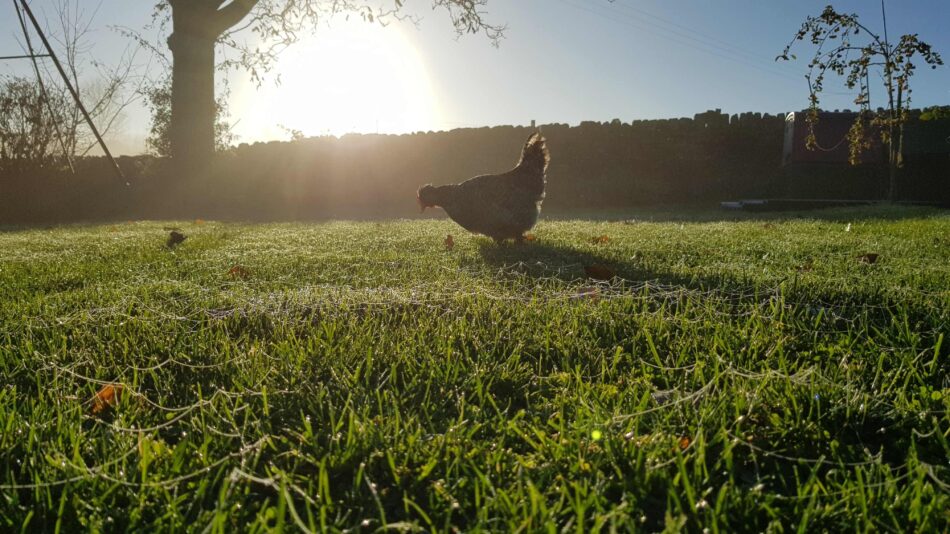
This entry was posted in Chickens
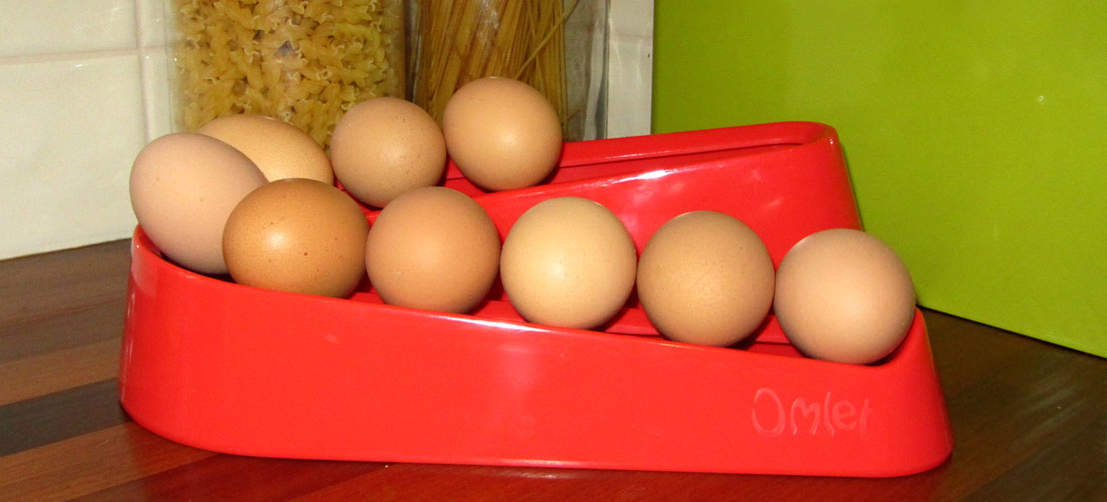
Established in 1996, World Egg Day falls on the second Friday in October, meaning that this year we get to celebrate on the 8th of the month. If it’s your first time celebrating, take a look at these egg recipes for some inspiration on how you can make some protein-packed meals with your eggs, or how about partaking in local events or competitions like an egg and spoon race.
So, with World Egg Day just round the corner, it wouldn’t be right for us at Omlet to miss out on the opportunity to share some fascinating facts!
You Can Predict a Hen’s Egg Colour by Looking in Their Earlobes
You can usually tell if a chicken will lay brown eggs if they have red earlobes. Hens who will lay white eggs will probably have white earlobes. There are, of course, some exceptions to this but test it for yourself by taking a look at your chickens!
Hens Turn Their Eggs Nearly 50 Times a Day
A hen will turn their eggs nearly 50 times in one day when waiting for them to hatch. This is so that they can keep the embryo positioned properly, preventing the yolk from sticking to the side.
You Can Find Out Whether an Egg is Raw or Hard-Boiled by Spinning it
You can try this out as a fun activity by boiling some eggs and leaving others raw to test your friends and family. If your egg spins easily, this means that it has been hard-boiled. However, if it wobbles, it is raw. The science behind this is that a hard-boiled egg will spin easily because its centre of gravity is fixed, whereas with a raw egg the centre of gravity changes, as the liquid inside the egg moves about.
The Furthest Distance That an Egg Has Been Thrown and Caught is 98.51m
There are a number of world records when it comes to eggs. In 1978 Johnny Dell Foley threw a hen’s egg a very impressive 98.51m to Keith Thomas in Texas, USA, without breaking it. That’s nearly the distance of a 100m sprint!
The Most Omelettes Made in 30 Minutes is 427!
Here’s another egg related world record for you. In 1990, Howard Helmer made a whopping 427 two-egg omelettes in the short space of 30 minutes! The record still hasn’t been beaten to this day.
Eggs Are One Food That Naturally Contain Vitamin D
Vitamin D, also known as the “sunshine vitamin” is key to the functionality of our bodies, playing a key role in supporting our immune systems. Very few foods naturally contain vitamin d, however egg yolks are an exception here, being a great source of it.
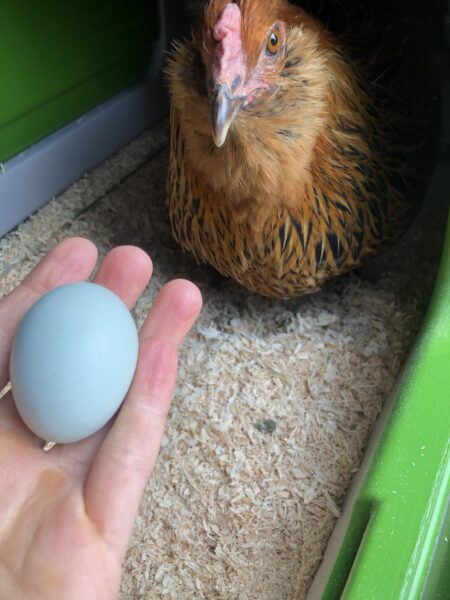 Some Chickens Produce Blue and Pink Eggs!
Some Chickens Produce Blue and Pink Eggs!
If you thought chickens only laid brown and white eggs, you were wrong! Who said that Dr. Seuss’s Green Eggs and Ham was just a fictional story?! Several chicken breeds such as the Araucanian are known to naturally lay blue, green, and pink eggs!
The Average Person Consumes 173 Eggs a Year
This means that around the world, approximately 1.2 trillion eggs are produced for eating every year. A bonus fact: in Chinese households, the average person eats roughly 300 eggs per year. That’s a whole lot of eggs!
It Takes a Hen Between 24 and 26 Hours to Produce One Egg
Hens tend to take between 24 and 26 hours to produce and lay one egg, around 20 of these being just to form the shell. Following this, it takes a further 15 to 30 minutes for the process to start all over again.
With 2021 being the 25th anniversary of the event, you can really go all out this year, with celebrations happening around the world. Hopefully these fun facts will have given you some inspiration to maybe take on a world record yourself!
This entry was posted in Chickens
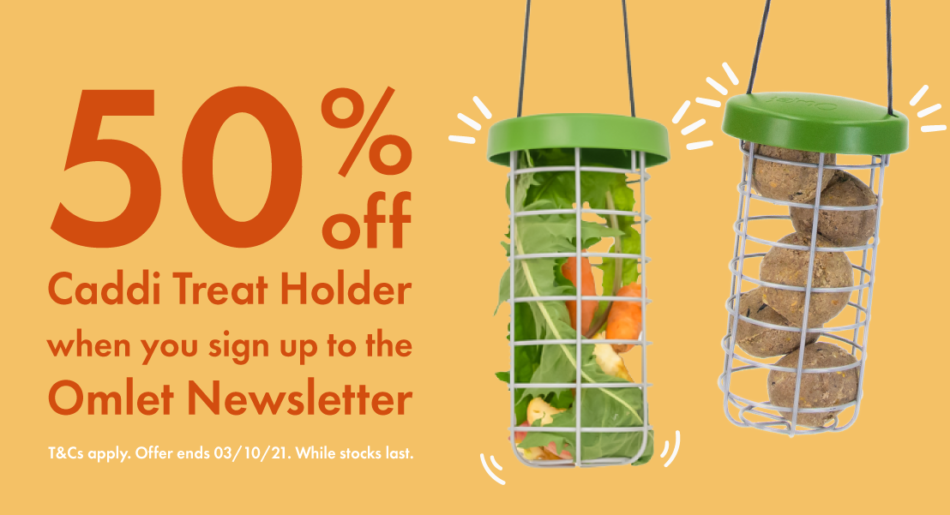
Ever cleaned your pets’ run and found old bits of mouldy cabbage or soggy feed that is nearly impossible to pick out of the grass? There is an easy way of keeping your pets’ treats fresh for longer, while also improving run cleanliness AND keeping your animals entertained!
The Caddi can be hung at any height from all pet runs, trees or other structures in your garden. It’s super easy to fill with whatever you want to give your pets, be it bits of fruit, fresh hay or Feldy Chicken Pecker Balls.
At the moment you will get 50% off Caddi Treat Holders for chickens, rabbits and guinea pigs when you sign up to the Omlet newsletter. Take this opportunity to make your pets’ run funner and more hygienic than ever before!
4 reasons Caddi will improve your pets’ run:
All pets will be happier if their living quarters are tidy and clean, but it’s also important for their health that both their coop or hutch and run are kept hygienic. Mouldy food left on the damp ground can make a chicken, rabbit or guinea pig very ill, so having a Caddi to keep it in will make it much easier for you to spot anything that’s gone off, and to remove it in a second.
Food, treats or hay that is left on the ground on the run will go off very quickly, especially at this time of year when temperatures can vary dramatically between day and night and there is likely to be more rainy days. With the Caddi, the treats you leave your pets will keep fresher for longer as they won’t come into contact with the wet ground. They will also be kept dryer thanks to the waterproof top.
The end of summer means that there will be less food available for wild animals like rodents and small birds, and they are likely to approach your garden and your pets’ home in search for tasty morsels. By putting feed, hay or vegetables in the Caddi rather than scattering on the ground, you are making things more difficult for uninvited visitors!
As the treats, veg or hay you are giving your pets are kept contained in one place and won’t get stepped on by muddy feet, they will be crunchier, cleaner and better tasting. As the swinging motion of the Caddi offers stimulation and entertainment, your pets will truly enjoy snacktime!

Buy now and get 50% off when you sign up for the Omlet newsletter!
Terms and conditions:
This promotion is only valid from 28/09/21 – midnight on 03/10/21. Once you have entered your email address on the website you will receive a discount code that can be used at checkout. By entering your email you agree to receive the Omlet Newsletter. You can unsubscribe at any point. This offer is available on single Caddi Treat Holders only. The offer does not apply to Twin Packs, Twin Pack with Peck Toys or packs with Feldy Chicken Pecker Balls. Excludes all other chicken accessories. Offer is limited to 2 Caddis per household. Subject to availability. Omlet ltd. reserves the right to withdraw the offer at any point. Offer cannot be used on delivery, existing discounts or in conjunction with any other offer.
This entry was posted in Chickens
It’s often hard to tell if a hen is laying. Hens do not produce the same number of eggs each week throughout the year, and there may be health- and environment-related changes to egg production, too.
It’s useful to know when a hen stops laying, as you can then give her a quick health check to identify the cause of the interruption. But how do you tell which chicken is not laying eggs? In a coup of six hens, in which the daily average number of eggs is five, it’s not immediately obvious which hens are laying.
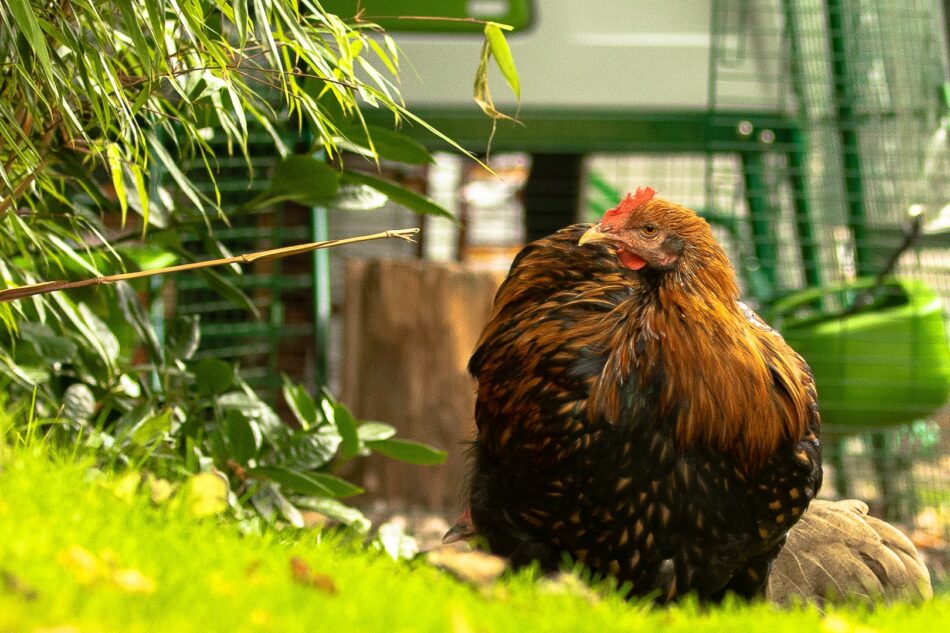
Seven signs that a hen has stopped laying
1. Age. This is the most obvious cause of a drop in egg production. Over her egg-laying years, a hen’s production will tail off. This is natural, and it does not mean the chicken has reached the end of its usefulness. All hens play a part in the social order of a coup, and a bird reaching the end of its egg-laying life will still be as feisty, active and lovable as the younger birds – and she’ll still lay the occasional egg.
2. Moulting. This occurs every year once a hen is 18 months old (although younger birds may shed feathers, too). The signs are very clear – lots of feathers lying in the coop, and bare patches appearing on the hen. During this time, chickens need to produce lots of new feathers, which is a physically demanding process. Consequently, egg-laying is reduced, and sometimes there will be several days without an egg. The moult tends to occur in the autumn, but it depends on when the hen first started laying. Moulting takes 8 to 12 weeks, occasionally longer.
3. Vent. A dry vent – the hole through which the hen lays her eggs – is a sign of no production. In a hen that is still laying, the vent will be moist.
4. Abdomen. Your chicken’s abdomen area should feel soft and rounded. If the area below the breast bone is hard and swollen, this can be a sign of egg peritonitis, a bacterial infection in the chest cavity. Your chicken will still produce a yolk but is free-floating in the abdominal cavity. Affected hens will stop therefore either completely stop laying eggs or only lay soft-shelled, thin, or misshapen eggs.
5. Comb and wattles. A healthy laying hen tends to have bright red comb and wattles. These become duller when she is about to lay, but turn bright red again once she has laid the egg. If the comb and wattles are pale or dull looking all the time, it could be a sign of illness.
6. The food dye test. If you put a small dab of food colouring on a hen’s vent, the colour will be transferred to the egg. The colour that fails to appear tells you who the non-layer is. This is only practical in smaller flocks, though, given the limited palette of food colourings…
7. No eggs. This isn’t as silly as it sounds! If you only have a few hens, and they are different breeds, you will often come to recognise which eggs are produced by which hen. In this case, the sudden disappearance of one particular egg-type will tell you who’s not laying.
Five reasons why hens stop laying eggs
1. Temperature and sunlight. Seasonal factors play a part in egg production. As the daylight hours lessen in autumn and winter, hens tend to lay fewer eggs. In the depths of winter, the low temperature becomes the cause, as a hen needs all her energy to produce body heat. With her resources diverted to this essential function, egg-laying is put on hold.
2. Stress. Any form of stress will tend to interrupt or stop egg production. Stress can be brought on by several things, including parasites, bullying, injuries and fear (of noisy dogs, for example).
3. Diet. Poor diet can impact egg production, too. If a hen is laying, she needs all the essential nutrients – not just calcium – to produce eggs. Top-quality layer’s pellets will contain everything the hen needs. A hen that fills up on treats before filling up on pellets may become malnourished and stop laying. It’s a good idea to let the chickens feed on their pellets first thing in the morning and last thing at night, and only offer corn and treats in the middle of the day.
4. Broodiness. A broody hen – that is, a hen who has decided to sit on her eggs in an attempt to hatch them – will stop laying. There are several ways of discouraging broodiness, but some hen breeds are more prone to it than others. If all attempts to dissuade her from leaving the nesting box, you have the consolation that after 21 days – the time it would take for a fertilised chicken egg to hatch – the hen’s self-inflicted ordeal will be over and she will resume normal life – including egg-laying.
5. Change of routine. If you move the hen house or introduce new birds to the flock, or if one of the hens dies, the birds’ routine and pecking order will be interrupted. This often causes them to stop laying for a short time, until their social lives settle down again.
Four ways to encouraging laying
1. Comfy coop. The first thing to do is to make sure the hens’ environment is adequately equipped and comfortable. Check for red mites, as an infestation of these nocturnal parasites can stop egg production. Reduce drafts and make sure there is no bullying going on – often a sign of an overcrowded hen house. You can read more on how your chickens’ coop can impact their laying in our blog How Long Can Chicken Eggs Stay in the Coop?
2. Light. Some chicken keepers install lights in the coop to encourage laying in the colder months of the year. However, bear in mind that a chicken can only lay a finite number of eggs in its lifetime. If she’s naturally programmed to lay 1,000 eggs, encouraging her to lay regularly throughout the winter will simply reduce her laying life.
3. Eggs. If an apparently healthy hen isn’t laying, she can be encouraged by leaving eggs in the nesting box, or placing rubber eggs, or even golf balls, in the spot where she is supposed to lay. The sight and feel of these will encourage her laying instincts.
4. Reduce stress. Discourage dogs from disturbing the hens, and make your chicken run and coop are as predator-proof as possible. Equally important, make sure the run isn’t overcrowded, and provide enough roosting space in the coop for all the hens to rest comfortably.
Disappearing eggs
If your hens are free-ranging, they will sometimes lay an egg in a quiet corner of the garden, meaning that your eggs are not in fact disappearing but rather being hidden out of sight! This can become habit-forming, and if she’s doing it in secret, you may reach the incorrect conclusion that the hen isn’t laying.
A healthy hen who does not appear to be laying may be the victim of egg sabotage. A predator, a human thief or an egg-eating chicken might be removing the evidence of her labours. The best way of preventing this is to encourage your hen back to the nest box for laying. In crowded coops, a hen will sometimes seek an alternative laying place if the boxes are all full when she feels the urge to lay.
As a hen ages, she will produce fewer eggs. If you are uncertain of the age of your chickens, there is a simple test you can conduct that might sometimes give you a clue. Place your hand gently on a hen’s back. If she immediately squats down, it means she is still fertile and therefore producing eggs. Hens squat when they are mating, and it is an automatic response.
Although egg production drops as a hen ages, it will often continue throughout her life. The occasional egg from an old hen always reminds you what a wonderful friend she’s been throughout your long time together!
This entry was posted in Chickens

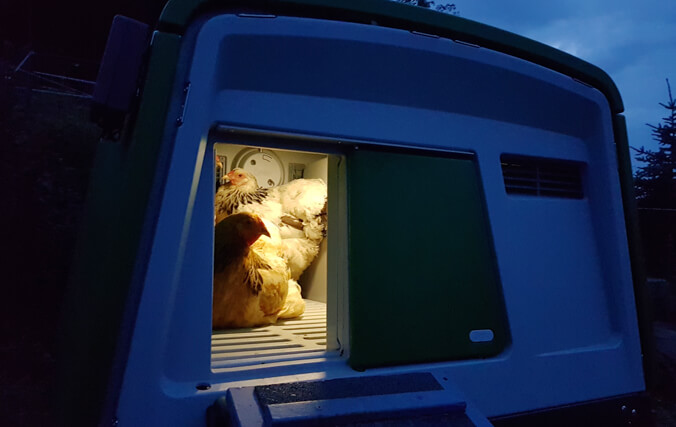
Your chickens’ coop should be a space for your flock to eat, drink, lay eggs, and sleep. It should also be a place for your chickens to feel safe and be protected from the outside elements or any danger. However, sometimes chickens may suddenly decide that they do not want to go into their coop at night, which can be for a number of reasons. Here are some explanations as to why this could be happening.
A Broody Hen
Hens can get broody, regardless of if you have a rooster. Although many hens will decide to stay in the nest of their coop so that they can sit on their eggs, others like to search for a quiet space away from the coop, which can mean remaining outside the coop all night.
Moving a broody hen can be highly stressful for them, so should you decide that it’s best to move your hen inside the coop, due to safety concerns, you need to take great care when doing so. One way to start is by collecting your hen’s eggs regularly (twice a day). Be sure to wear leather gloves when doing so, as a broody hen is likely to be aggressive around you as they are very protective of their eggs. You’ll also want to reduce the light supply when you move her, as the moving process situation will be less traumatic in the dark.
Predators
Predators such as foxes, cats, rats, and badgers could be one reason as to why your chickens have stopped going inside the coop at night. These animals will spook your flock, with smaller predators such as badgers having the potential to gain access inside the coop by climbing over the fencing, or squeezing through small openings in the coop’s wiring.
Luckily, there are a few steps you can take to deter these animals and have your chickens back in their coop every night. One option is to get a motion sensitive light installed, which will scare off any unwanted guests. Alternatively, take a look at the Omlet chicken coop range. All of the Omlet coops are predator resistant, which will reassure you that your chickens will be safe from any night time visitors. With anti-tunnel skirts that lie flat on the ground, and heavy duty steel weld mesh, these features will help to prevent animals from digging in. You can also purchase the Omlet automatic coop door which shuts your chickens away in their coop at night to keep your flock secure, enclosing them until the time you set for the door to open in the morning.
An Overcrowded Coop
Chickens need their own personal space, hence why many chickens are also kept free range. Not only is overcrowding an unpleasant experience for chickens, causing them to avoid the coop at night, it can also lead to further complications such as the build up of ammonia and an increase in disease. The solution? The more space the better! For size reference, the Omlet Large Eglu Cube chicken coop can comfortably accommodate six large hens or up to ten bantams.
Tensions Amongst Your Chickens
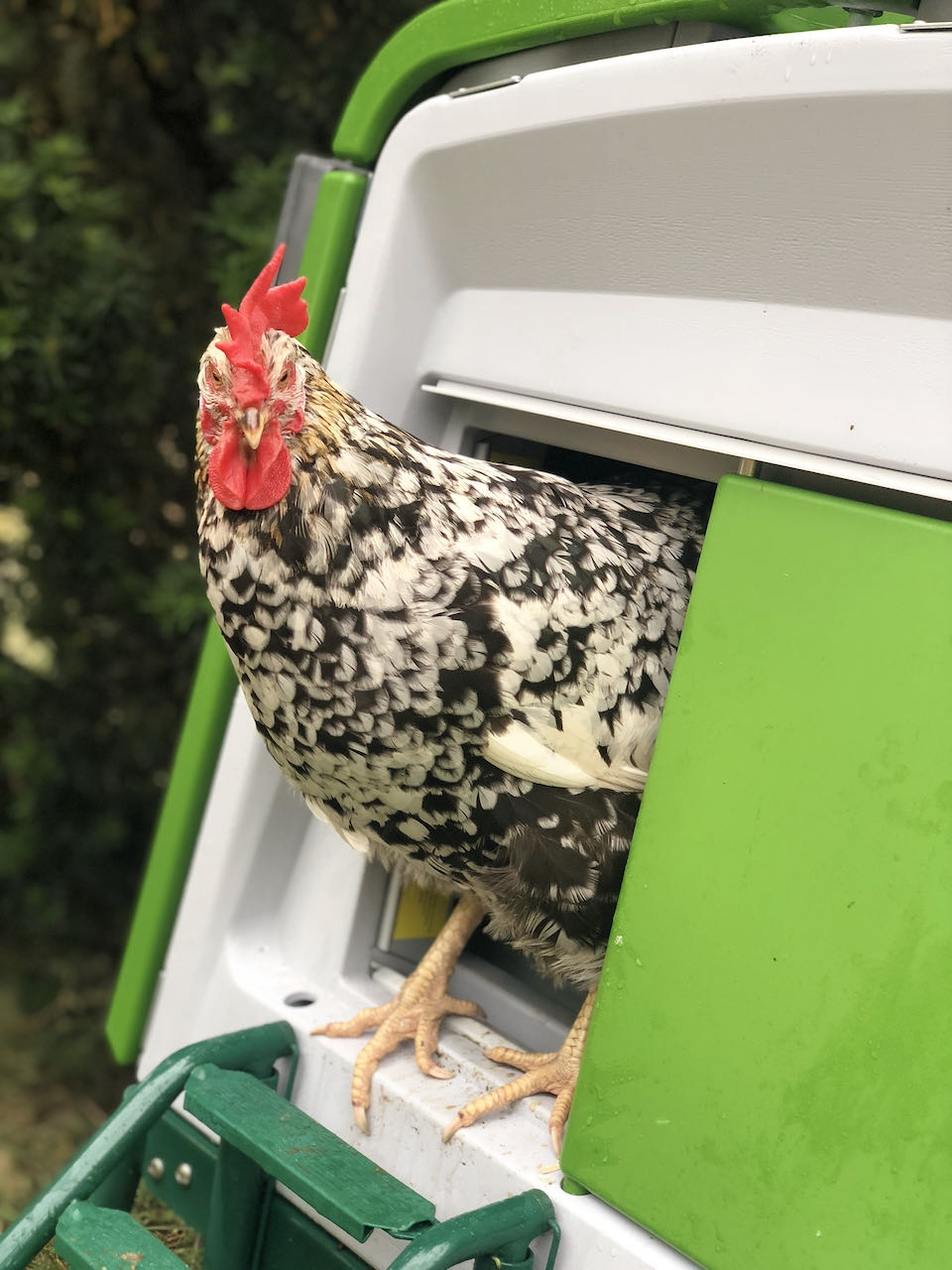 Unfortunately, bullying amongst chickens happens, and isn’t actually too uncommon of a problem. Chickens naturally create a pecking order, whereby the flock will establish themselves in a social hierarchy of strongest to weakest chicken. However, if aggressive behaviour continues after the head rooster, or the dominant hen in their absence, has found their way to the top of the ladder, you may be dealing with a bully. Common signs are missing feathers from a chicken’s back, unusual weight loss, reduced egg production, or blood from where the victim has been pecked, all of which could lead to a chicken/s refusing to go into their coop at night.
Unfortunately, bullying amongst chickens happens, and isn’t actually too uncommon of a problem. Chickens naturally create a pecking order, whereby the flock will establish themselves in a social hierarchy of strongest to weakest chicken. However, if aggressive behaviour continues after the head rooster, or the dominant hen in their absence, has found their way to the top of the ladder, you may be dealing with a bully. Common signs are missing feathers from a chicken’s back, unusual weight loss, reduced egg production, or blood from where the victim has been pecked, all of which could lead to a chicken/s refusing to go into their coop at night.
To stop the bullying, and therefore get your chickens back in their coop at night, first try to establish the cause. Common reasons for bullying can be an injured or ill bird, having a large flock, or your chickens being bored. However, should the bullying continue after attempting to resolve what you believe to be the cause of conflict, you can purchase anti-pecking spray, which will discourage feather pecking. Alternatively, separate the bully from the flock. Isolating the bully for a week may mean that they lose their dominant position in the hierarchy once they are reintroduced.
Mites and Parasites in the Coop
Pests are a very common cause for chickens to have stopped going to their coop at night. Red mite in particular is a likely culprit, a parasitic mite that lives inside chicken housing and lays eggs in cracks near nests. They can make your chickens restless at night, as they live inside chicken coops and crawl onto the chickens to feed on their blood as they sleep. Only active during warmer weather, red mites are also more likely to strike wooden coops.
Red mites are not the easiest thing to get rid of, however, one solution is to purchase red mite treatment, which works by immobilising pests with its sticky consistency. Rest assured, it’s also completely safe to use in the chicken feeding area, so you do not have to have any concerns about your flock digesting the product.
Luckily, chickens are creatures of habit, so once you’ve identified the cause, you should be able to get your flock back into the coop at night in no time!
This entry was posted in Chickens
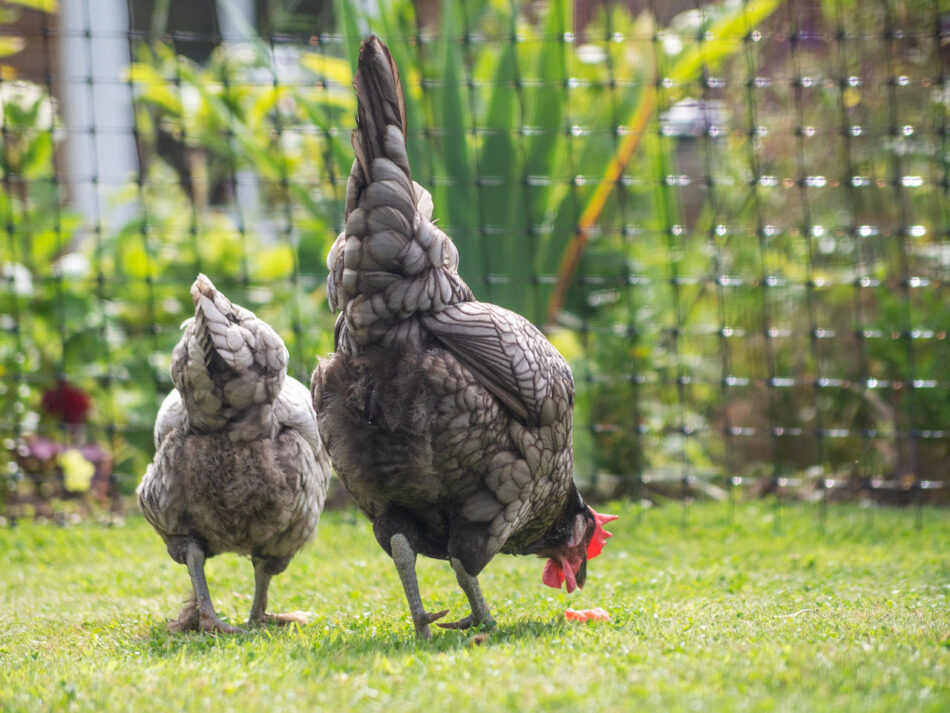 As the days get shorter, you might find that your chickens are not laying as much as they normally do. Egg production is partly regulated by daylight hours, and the more light the chickens see, the more eggs they will lay. Other factors that can affect the production are moulting, broodiness and your hens getting older.
As the days get shorter, you might find that your chickens are not laying as much as they normally do. Egg production is partly regulated by daylight hours, and the more light the chickens see, the more eggs they will lay. Other factors that can affect the production are moulting, broodiness and your hens getting older.
But if you find that you’re collecting significantly less eggs than you did six months or a year ago, there might be some things you can do to encourage your hens to start laying again and get the most eggs possible from your flock. Have a look at our tips below!
1. Choose the right breeds
If eggs are the number one reason you keep chickens, you should make sure you pick hens for your flock that through generations have been bred to lay. Bantams or more decorative breeds like Polish and Silkies generally lay relatively few eggs, as do the larger breeds that were developed for meat.
The ideal egg layer is also hesitant to sit on her eggs, and rarely go broody. Some examples of breeds that lay many eggs are Australorp, Sussex, Rhode Island Red and Leghorns.
2. Give your hens a good quality feed
It’s always important to give your chickens the best possible quality feed you can, but extra important if you want them to produce eggs. A good feed should have a good amount of protein (16-20% depending on the age of your chickens) as well as important vitamins and minerals.
If you feed your chickens treats, they should be kept to a minimum, and be low in fat. Fat or obese chickens will not lay, so make sure they fill up on good feed, a handful of corn, and maybe some delicious worms from the garden. That should keep your hens happy and healthy, and hopefully laying regularly.
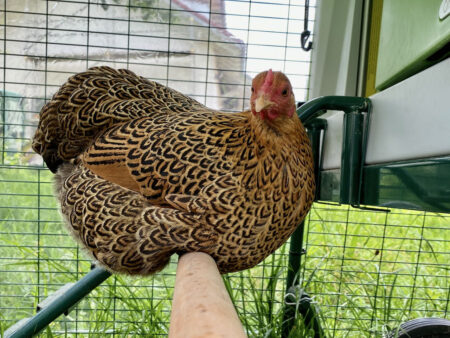 3. Minimise stress
3. Minimise stress
Chickens that experience stress on a daily basis will put all their energy into being constantly on their toes, and will produce no or very few eggs.
Make sure your birds feel safe in their chicken coop and where they are free ranging. A predator resistant coop and run, like the Omlet Eglu Coops, will allow your chickens to roost away from any danger. Try to keep cats and dogs away from the area where your chickens are roaming, and let the hens come to you rather than chasing them around the garden.
Generally, hens will also feel most comfortable when you have a clear routine. Let them out of the coop around the same time every day (made super easy with an automatic chicken coop door), feed them the same feed at the same place, and put them to bed when they’ve all returned to the coop.
Sometimes it’s impossible to avoid a certain amount of stress, for example if you’re moving the hens to a new place or are introducing new chickens to your flock. The chickens should return to their normal laying pattern once things have calmed down, but you could experience a few weeks of disturbed laying.
4. Give them plenty of calcium
Chickens need calcium to create strong egg shells. A good feed will contain a fair amount, but you should also provide your laying hens with an additional source, most commonly oyster shell or crushed, baked egg shells. You can read more about this topic on our previous blog How Long Can Chicken Eggs Stay in the Coop?
5. Provide fresh water
A chicken can drink up to a pint of water a day (!), so it’s important to give your flock plenty of fresh, clean water. Chickens will happily drink from muddy puddles and other water sources, but as standing water can contain bacteria and parasites it’s always best to make sure they have plenty of clean water to drink from their drinker.
This is especially important in the warmer months, as a dehydrated chicken will not lay, but also make sure the water doesn’t freeze in winter.
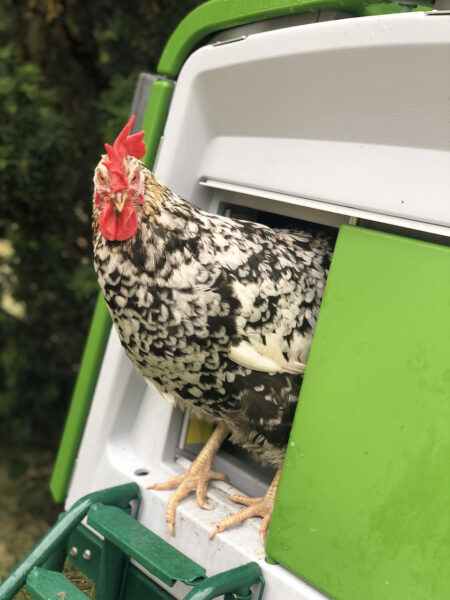
6. Keep parasites at bay
Mites are the number one culprit when it comes to a decreased egg production. They suck blood from the chickens’ legs at night, resulting in the hens being anemic and too tired to lay. Fleas and lice can really annoy chickens and make them stressed, and internal parasites like worms will lower your hens’ immune system and possibly make them very ill.
Get into the habit of checking your chickens over every, or every other, week by picking them up and going through their face, feet and feathers. That way you will be able to spot a potential problem early, and hopefully treat it before it affects your pets and their egg production. You can read more about giving your chickens a health check here.
7. Keep the chicken coop clean
Just like you and I, chickens don’t like sleeping, eating and socialising in mess and dirt. Their idea of cleanliness might look slightly different from ours, but if you want your chickens to be happy and healthy and lay plenty of eggs, you must make sure the coop and the run are tidy and free from poo and dirt.
With a chicken coop like the Eglu Cube, making sure the hens’ home is clean is super easy. Thanks to the wipe down surfaces and the handy pull out dropping tray, it will only take minutes to clean the coop.
Fill the nest boxes with plenty of soft bedding so your hens have somewhere comfortable to lay.
8. Provide more space
Lack of space can lead to a lot of stress for chickens. While roosting they prefer sitting close together in the coop, but during the day it’s important that they have a good amount of space to move around on.
If you chickens aren’t laying, maybe consider giving them a slightly larger run or area to free range on. Or if you have introduced new hens to your flock, it might be time to buy a second coop to house one half of the group.
Chickens, like most animals, have a defined number of eggs in their bodies, and once they have used up their reserves, nothing you do will make them produce more delicious eggs. If you have rescued ex battery hens for example, the rate of egg laying might slow down quite quickly, despite the hens still being young, as they have lived in an environment where they were manipulated to lay as much as possible, as quickly as possible.
It’s also good to remember that chickens are not machines, and their bodies will sometimes just need a rest. This doesn’t mean they will never lay again, so don’t give up on them! After all, as well as eggs, our chickens provide us with plenty of entertainment and companionship, and they deserve to be properly cared for however many eggs they produce.
This entry was posted in Chickens
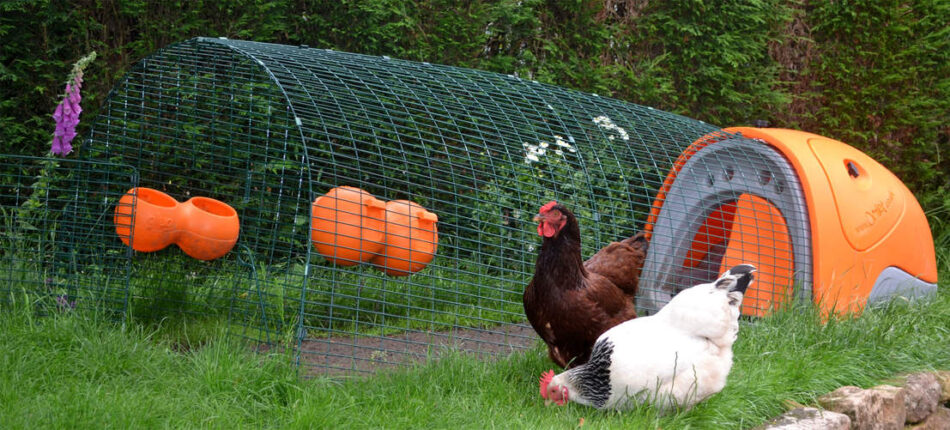
The Eglu Classic Chicken Coop is an easy to move starter chicken house suitable for 2-4 birds.
Unless you know exactly when your hens were born, it is difficult to determine their exact age. We can’t simply ask them how old they are, so we have to make educated guesses based on their looks and behaviour.
Like most animals, a chicken’s looks and behaviour gradually change as they age. It is the visible evidence of these life stages that helps us determine a hen’s age. Young birds are the easiest ones to identify, as chicks do not have a complete set of adult feathers, beginning life with the short-lived fluffy yellow coating called down. They wear this attractive yellow coat for the first week or so of their lives.
After the first couple of weeks, chicks gradually moult their down and small feathers begin to grow to replace it. A baby chicken can be considered a chick until it sheds all its down, which usually takes around 12 weeks.
So, if a chicken still has some down, chances are it is 12 weeks old or less, although some breeds may take a while longer to shed all their baby fluff. But, generally, the more down, the younger the bird.
From chick to pullet
Once a chick has moulted and lost its down, it enters the transitional period between chickhood and adulthood, the chicken equivalent of teenage years. Hens over the age of 12 weeks are in this phase, and are known as pullets. This period of their lives usually lasts until 20 weeks old, though it can be longer. The name ‘pullet’, though, is generally used for any hen under one year.
Pullets are considered adults when they lay their first eggs, which occurs somewhere between 18 and 25 weeks. Male chickens – cockerels, or roosters – reach adulthood when they start to crow and show an interest in the hens, usually by chasing them. This occurs at around five months old, although some breeds are later developers.
At this point in a chicken’s life, when it has finally become an adult bird, it is hard to pinpoint exactly how old they are. If your hens are not laying eggs yet but have all their adult plumage, they are most likely somewhere between 12 and 20 weeks old. Young hens of this age will tend to have smaller combs than fully adult birds.
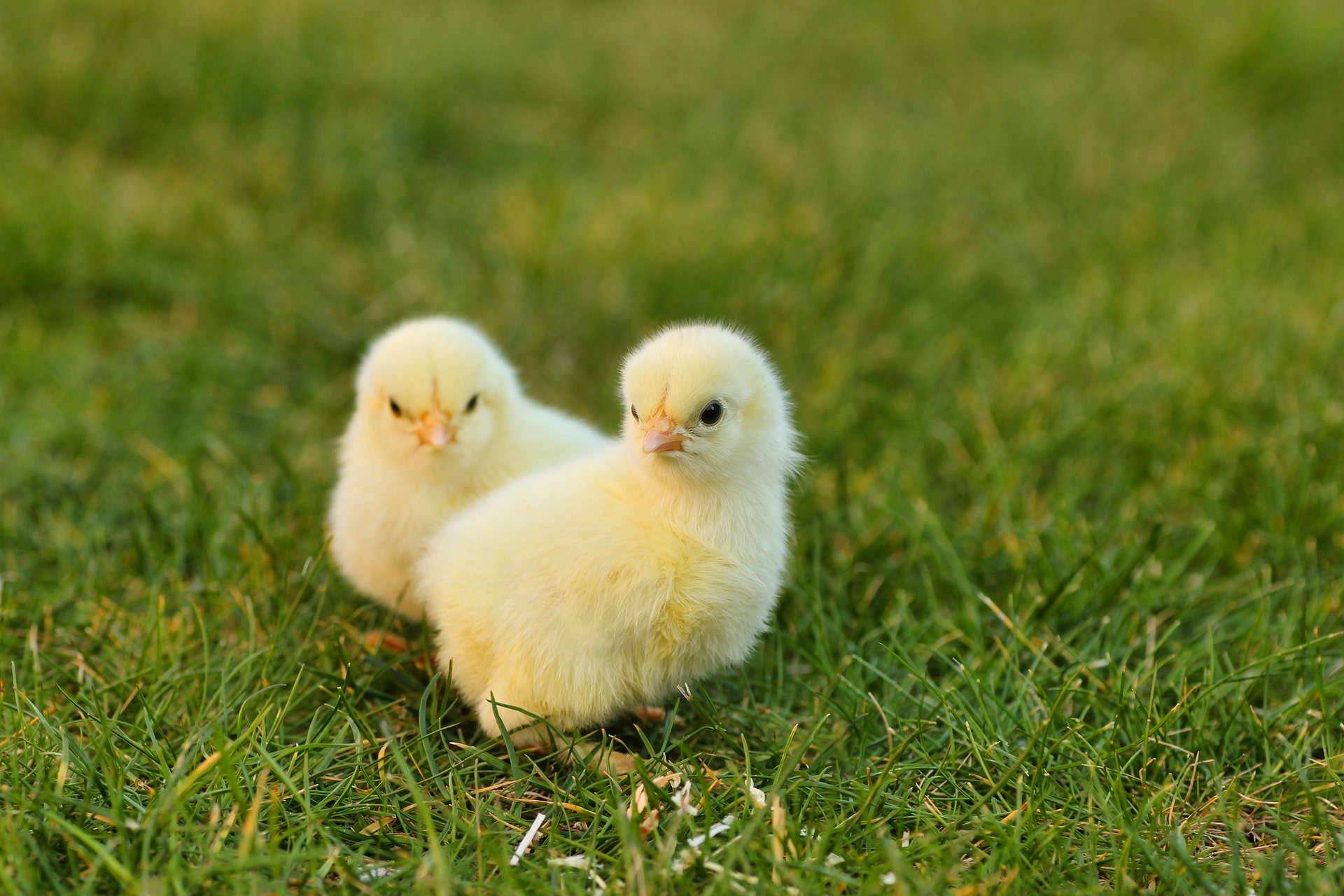
From pullet to adult hen
If you are keeping multiple hens, it can be hard to tell if an individual bird has started laying or not. Pullets will have small, dry and pale vents in comparison to hens, and this can be used as a way of telling whether or not they are laying.
During this post-20 week period, both the pullets’ and cockerels’ combs and wattles will gradually become brighter and more pronounced. Birds with less vibrant combs and wattles are most likely to be aged around 12-15 weeks. It is during this prime egg-laying stage of a chicken’s life that their combs and wattles will be at their most vibrant – as a hen ages, it slowly loses the red colour.
Hens increase their body mass as they mature, and most have reached maximum plumes at nine months old.
Signs of an adult chicken
Once your pullet has laid its first egg, and your cockerel has started crowing and harassing the hens, they have reached adulthood. Despite the fact that they are considered adults at this point in their lives, they are still growing (albeit slower) and will reach their final size and weight at around one year.
At this age, hens will usually be laying one egg per day, and the cocks will spend a lot of time chasing the hens. At the age of 18 to 20 weeks, the chickens will have their first feather moult.
Guessing the age of a fully grown chicken that has had its first moult is more challenging. However, there are some features that help us determine their age with reasonable accuracy.
- A young cock will have short spurs, a little under 1cm in length. By the time your rooster is two years old, their spurs will have grown and may reach lengths of 2.5cm-3cm.
- Hens that lay an average of five to six eggs per week are probably in the first two years of their life
- For the first two years of their adult life, both hens and cocks will be in their prime. This manifests in vibrant feather colours, smoother legs than older birds and colourful combs and wattles.
Older hens and roosters
At around the second year of their lives, chickens will enter the second half of their adult lives. It is usual at this time for hens to stop laying daily, and cockerels will start showing less interest in the hens.
During this time, a chicken’s legs will start to get rougher and more scaly, and their combs, wattles and feathers will become less vibrant.
However, although past their prime, at this point in their lives, a chicken will still have around between two and five years left in them, depending on the breed. As they get older, hens will only lay occasionally, and the eggs may be larger than the ones they laid as young birds. However, some breeds continue laying into their fourth year, and some can live up to 10 years or more.
This entry was posted in Chickens
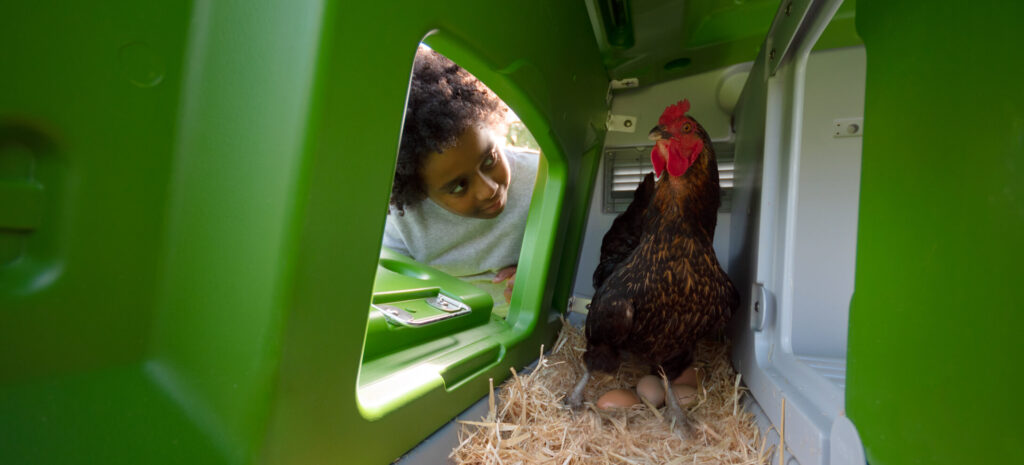
It’s frustrating when a hen decides to ignore the comfy nesting boxes and lay eggs on the floor of the coop or run instead. Chickens love routine, and once they get into the habit of laying eggs on the ground, it can be hard to change their routine.
The main disadvantage to laying an egg on the ground is that it can be damaged. It can also be pecked, as chickens tend to peck at anything they find. If hens acquire the taste for fresh eggs, they tend to peck at every egg they can find, which is disastrous.
Luckily, there are a few ways of persuading a hen that nesting boxes are the best place to lay eggs.
1. Make sure you have enough nest boxes
You will need space for all the hens to lay, which generally means one box for every four hens. Note: if there are too many nest boxes, some of them will be ‘vacant’, and one of the hens might decide to move in permanently, using it as her sleeping box, and it will soon become fouled with droppings.
2. Make the nest boxes clean and comfy
The nest box should have lots of soft bedding, changed regularly to make sure it remains unsoiled and free of red mites. You also need to collect the eggs regularly, as a hen faced with a pile of eggs might not want to sit there and lay one of her own. A nesting box with just one egg or none is more appealing to a hen.
3. Provide enough roosting bar space
This might not seem linked to nest boxes and eggs, but it’s actually vital to the process. Chickens need space to perch when roosting. If there isn’t enough of it, some hens will be forced to look for space elsewhere, and that means they’ll occupy a nesting box. Being stubborn creatures of habit, once they’re installed, it will be hard to evict them.
4. Tempt the hens in with an egg
Young hens might not know instinctively where to lay their eggs. If you place a ceramic or rubber egg in the nesting box, it will give them a visual clue, and once they’ve laid their first egg or two in the nest box, the habit will be ingrained.
5. Keep hens in the coop first thing in the morning
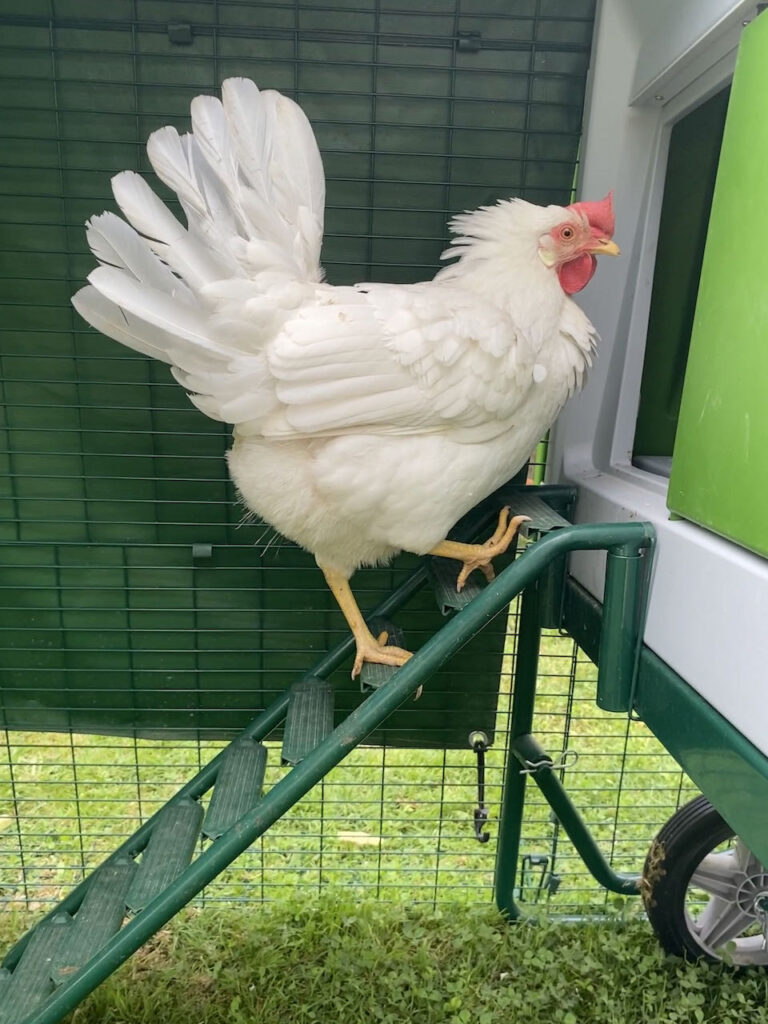
Most hens lay their eggs early in the morning, so confining them to the coop until the sun has been up for a bit will prevent them from wandering away and laying eggs in inappropriate places.
6. Make it harder for the hen to lay in the wrong place
As creatures of habit, hens tend to lay in the same ‘wrong’ spot each time. If this is on the ground, you can put a rock there, or some sticks or plastic bottles.
7. Move the hen before she lays
You will start to notice when a hen is ready to lay on the ground. She will stop her usual foraging and clucking and snuggle down. Move her to the nesting box when she does this, and she will soon – in theory – get the message and go to the box when she needs to lay.
8. Stop hens from sleeping in the nesting boxes
A hen who sleeps in a nest box will mess it up overnight and not want to lay her eggs in the same place. Shoo any hens from the boxes in the evening as they are settling down to discourage the nest-sleeping habit. If the problem is more to do with the roosting bars being hard to access, address that issue instead.
9. Make sure the hens feel safe in the box
If the nesting box is too close to the ground, or if bright light leaks in, or if noisy pets or children play next to it at the crucial laying time, hens will be discouraged from laying eggs there. Make the habitat as hen-friendly as possible. Raising the boxes a few inches from the ground is a good start (but not so high that young birds can’t access the box).
10. Make sure your hens can easily access the nesting box
This may sound obvious, but it is sometimes overlooked. A poorly designed coop might make it difficult for hens to access the boxes and lay eggs in the nest, in which case they will take the path of least resistance and lay elsewhere. The nest boxes may be too low or too high, making it difficult for smaller chickens to access, or the roosting bars might block easy access to the boxes.
You can bypass all these issues by installing your hens in a well-designed coop such as the Eglu. All hens prefer to lay in a quiet, dark, comfy spot, so a nesting box will nearly always be their first choice. It’s a simple case of ensuring they have the space and easy access to a clean, appealing egg-laying space.
This entry was posted in Chickens
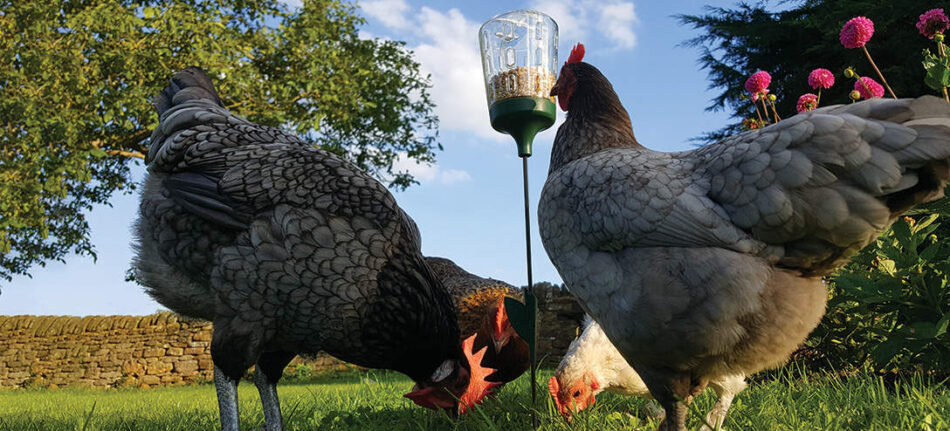
Chickens are not only great companions, but also a great way of being more resourceful, providing you with a frequent supply of fresh eggs. However, you could have a problem on your hands if you begin to notice that a few eggs are going missing. Sometimes chickens develop a bad habit of eating their own eggs, which although is not detrimental to their health, is a sure sign that something is not right.
Your Chickens are Bored
Your poor chickens may simply be suffering from boredom! Boredom in chickens can occur when they either don’t have enough space to roam, or they’re lacking facilities to keep them entertained.
For a happy hen, they need a bare minimum of 1 square metre each in their run, however 2 square metres plus (per hen) is always preferable. Chicken toys are also a fantastic way to keep your chickens entertained. How about trying out the Omlet Pendant Peck Toy, an interactive and engaging feed toy that not only improves flock behaviour but will provide your hens with the mental stimulation they desire.
Dehydration
Chickens that eat their eggs may be dehydrated. Since eggs contain a large amount of water, your chickens may be resorting to eating them simply to keep themselves hydrated.
To stop egg eating behaviour, make sure that your hens are supplied with a clean water bowl/feeder at all times. During the warmer summer months, chickens need a lot more of it, so add some ice to their bowl or feeder to make sure they stay on top of hydration.
Vitamin Deficiency
A vitamin deficiency can be another reason as to why your hens have turned to egg eating. Your chicken’s diet is fundamental to their wellbeing, and a poor one could be depriving them of their nutritional requirements. Along with eating eggs, broken eggs can be another indication that your chicken is vitamin deficient, more specifically suffering with a calcium deficiency.
It’s important to provide your chickens with a balanced diet of enough protein, carbohydrates, vitamins, and minerals, so although they naturally forage, you should supply your chickens with a good quality feed. For added calcium, it’s recommended to add grit, a ground hard substance, to your chicken’s diet, which aids with digestion.
Inadequate Nesting Facilities
Your nesting box needs to be a secure and safe space for your hens. Egg eating can occur when your hens are uncomfortable with the nesting box, most commonly due to the bedding itself or exposing your chickens to too much light.
First of all, make sure that their nesting area has adequate bedding and is made of a comfortable nesting material. There are a number of choices of bedding to choose for your hens so if you notice that they are not getting on with what you’re currently using, try changing their bedding to see what works best for them. You’ll also want to keep on top of cleaning their bedding by replacing it weekly, also removing any droppings. The Omlet Eglu chicken coops make for easy cleaning, with integrated and private nesting boxes, whilst offering plenty of space that your hens will love.
An Anxious or Stressed Chicken
Chickens found to be eating eggs can also be suffering from stress or anxiety, which your hens can be experiencing for a number of reasons. Stress-inducing scenarios can be related to either handling, a new environment, the introduction of new chickens, extreme heat, or regular visits from predators.
Having an anxious hen isn’t pleasant for either you or them but fear not, as there are steps you can take to help minimise stress to help your egg eaters. Some stressful situations are easier to tackle than others, such as introducing new chickens or handling if these are two stressors. Take a look at Omlet’s guide on how to correctly handle your chickens and guide on introducing new chickens for some more help.
Still Struggling?
If you’ve tried all of the above, ruled out anything medical, and yet your flock remain stubborn with their egg eating habit, here’s what else you can do to try and tackle the problem:

Quickly Collecting Eggs
Quickly collecting eggs once they have been laid will give your chickens, or particular offender if it is just the one hen, less opportunity to eat the eggs. If possible, check the next box four times a day to start with. Hopefully after a few days, this will break the habit, and you can go back to collecting the eggs once a day.
Fake Eggs
Fake eggs can be made of wood, rubber, or ceramics and will leave your chicken pecking but will eventually become frustrated so that they’ll stop attempting to peck at real eggs.
Using Mustard
Create a small hole in your egg, empty the contents and fill with mustard. Mustard is a flavour that (most!) hens can’t stand so after a few attempts, they’ll likely stop attempting to eat eggs.
If you do have an egg eater on your hands, don’t panic! It may seem a bit odd, or the behaviour might confuse you but with a few tips you can get the habit well under control. Hopefully next time you go to collect eggs, you’ll have happy laying hens, with your eggs still intact!
This entry was posted in Chickens
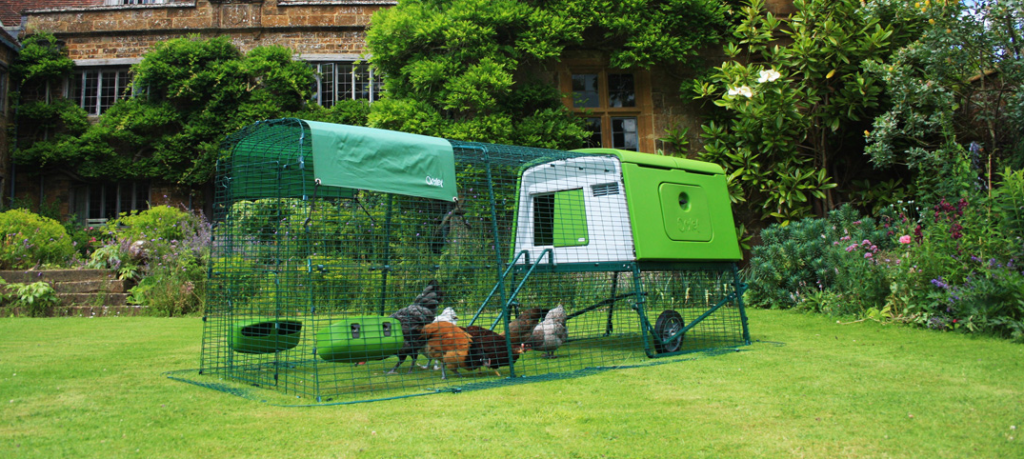
The metal chicken runs are designed to be used outdoors for years to come. However, we recommend that you check the run regularly for signs of corrosion, especially if you live somewhere with extreme weather conditions or close to the sea. Corrosion will occur if the coating has been scratched or scraped for example. If you do see some, remove any loose rust and touch up with a weather resistant paint.
Are you a long term Eglu or Walk in Run owner? Omlet products are known to be extremely long lasting, but we do recommend checking over your coop and run every year for signs of wear and tear, and to remember the little maintenance needed to keep your coop in tip top condition and your pet happy and healthy. You may have also missed some of the new products we have developed over the years to make the coop and runs even better. Take a look at ways you can upgrade and improve your Eglu below!
Run Clips
When you carry out your regular deep clean, make sure you have a quick walk around the run and check the security and stability of the run panels. In time, the run clips can age and become weaker. If you notice that run clips are cracking when you open them or move the coop and run, or that there are some clips falling to the ground, you should consider refreshing all the run clips on your coop.
We have now made it super quick and easy for you to find the right pack of run clips for your Eglu or Walk in Run.
New Ladder
If you purchased your Eglu before summer 2019, you may not have benefited from the new Ladder Grips we have designed to resolve the problem of some chickens disliking the metal coop ladder, or being too small for the steps. The ladder grips replace the black friction strips, clipping on securely and easily to provide a wider platform for chicks to climb up on.
You can buy ladder grips for your Eglu Cube here or for your Eglu Go UP here.
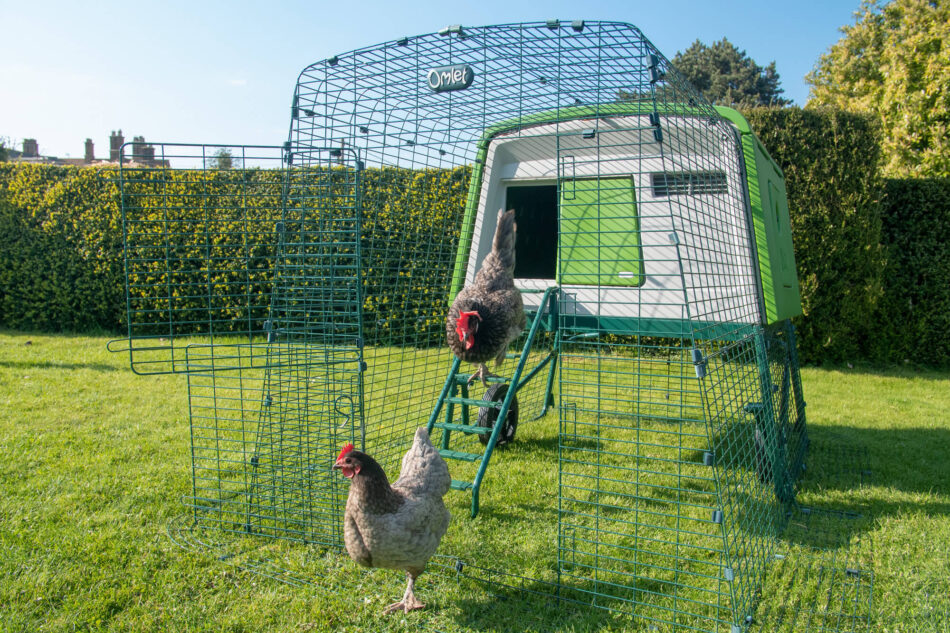
Autodoor and Coop Light
We’re sure you haven’t missed the Automatic Chicken Coop door that can be attached straight onto your Eglu Cube or Walk In Run, but have you seen that you can also attach a coop light to guide your chickens in at night? The light is powered by the control panel of the Autodoor, and will automatically come on 5 minutes before the door closes. As soon as the door has closed for the night, the light turns off.
Run Covers
In high winds and torrential rain, old run covers can take a beating. If you have had your run covers for some time and they are looking a bit worse for wear, it might be a good idea to invest in a new set of covers to ensure your chickens continue to be fully protected from the elements.
Discover our wide range of run covers for all Eglus here.
New hentertainment
We have also introduced new feeders and treat dispensing toys in the last few years, which your chickens are sure to love.
The Caddi Treat Holder is ideal for larger treats, such as fat balls or vegetables from your garden, and hangs in your run to keep food off the ground and prevent mess on the run floor. The Peck Toys are a rewarding, slow release solution for treat-dispensing which your chickens will be entertained by all day. The Pendant hangs from the run, while the Poppy is put into the ground – perfect if your chickens are fully free ranging.
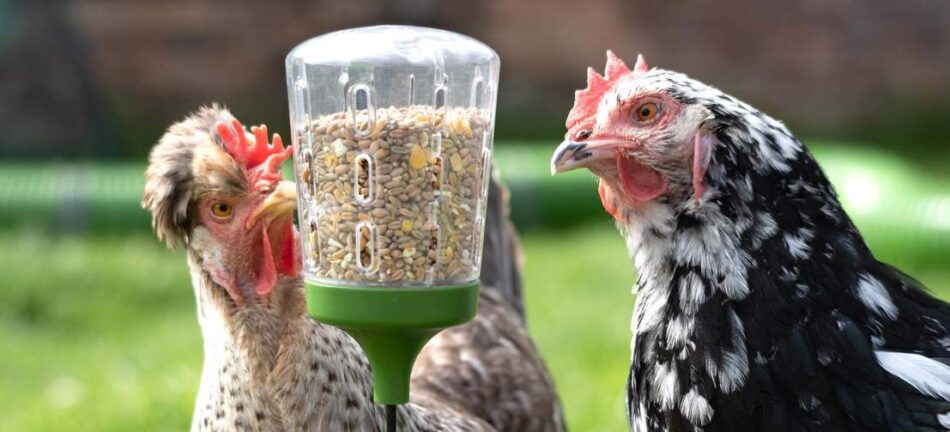
We’re here to help
If you are unsure about the condition of your Eglu or your run, please contact our friendly and knowledgeable Customer Service team. They can give you advice on how to maintain your product, making sure it’s in top condition for many years to come!
This entry was posted in Chickens
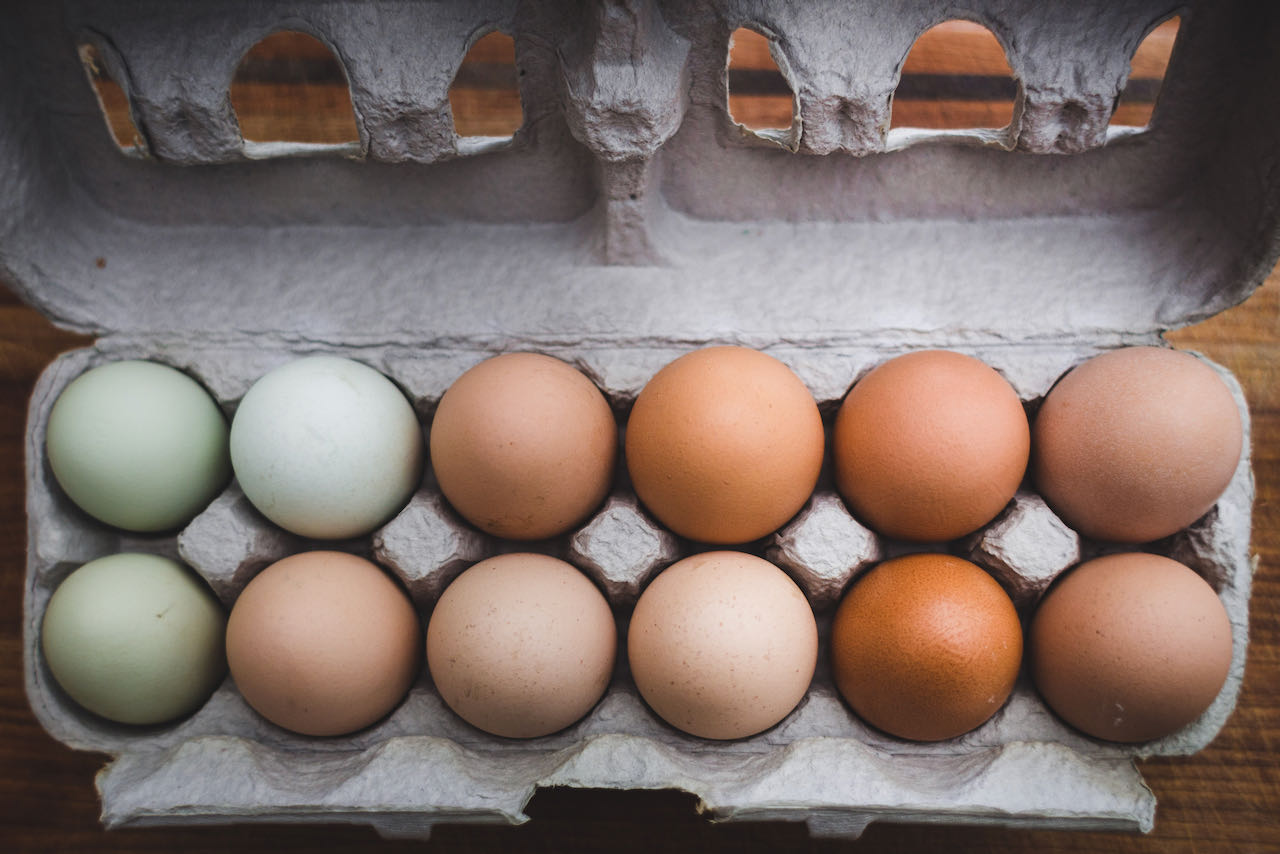 Chickens sometimes lay eggs that look nothing like a standard supermarket egg. Some are huge, some are tiny, some are ball-shaped, some are pointy, and some are soft-shelled. There are various reasons for these oddities.
Chickens sometimes lay eggs that look nothing like a standard supermarket egg. Some are huge, some are tiny, some are ball-shaped, some are pointy, and some are soft-shelled. There are various reasons for these oddities.
Each hen will have her own ‘quirks’ in terms of egg size and colour. Although most chicken breeds lay light brown eggs, some have eggs with pigmented shells. A hen will produce eggs of the same colour throughout her laying years. The palette ranges from deep browns to light blues and pastel greens, with speckling adding another dimension of prettiness.
Odd shapes and sizes are something quite different, though. They are quirks rather than breed-specific traits.
Why are chicken eggs sometimes bigger or smaller than usual?
A huge egg sometimes contains two yolks. In these cases, the hen has doubled up on her usual daily production and has had to produce a giant egg to accommodate the extra mass. These eggs usually have smaller-than-usual yolks, but they look very eye-catching in the poaching or frying pan!
Young birds often produce small eggs, and they will begin laying regular eggs very quickly. Some smaller bantam breeds produce small eggs all the time, of course.
Why are chicken eggs sometimes misshapen?
An oddly-shaped egg can be produced for various reasons. It often takes young hens an egg or two before they settle into their regular pattern. Stress in the chicken coop can lead to misshapen eggs too. This is usually due to a hen having the urge to lay but finding her space in the laying box occupied by another bird.
Misshapen eggs can be elongated, or they may have a thin, pointy end. Sometimes they are rough-looking, with craggy rather than smooth surfaces, or with thicker bands of shell running across their middles. In all these cases, the egg inside is unaffected and is perfectly safe to eat.
A ball-shaped egg is usually a sign of slight calcium deficiency. The round shape requires less calcium than a normal oval egg.
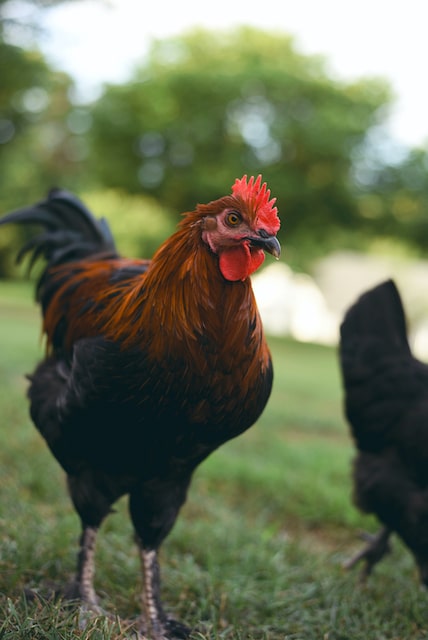 Are oddly-shaped chicken eggs a sign of illness?
Are oddly-shaped chicken eggs a sign of illness?
Infectious bronchitis can lead to misshapen eggs. An infected hen will stop producing eggs for a few days or will only lay intermittently. The eggs she lays will have thin, wrinkled or rough-shelled eggs, and the white of the egg will be watery. It is also common for the affected eggs to have lighter-coloured shells than usual. The condition is rare, and chickens can be vaccinated against it.
Laryngotracheitis is another illness linked to egg abnormalities, and this, too, can be prevented through vaccination. Any ailment can cause a hen to become stressed, so, in theory, any illness can result in misshapen eggs.
Why do chickens lay freckled eggs?
Some breeds always lay speckled eggs. However, if a hen that typically produces plain eggs lays speckled ones, there are various possible causes. She may have been shocked or stressed in some way while the egg was forming, or she may have developed a quirk in the pigment-producing part of her egg-laying system.
Freckling is often the result of excess calcium production, sometimes associated with the ‘end of season’ laying at the beginning of winter. On some eggs, there is a marbled pattern rather than an area of freckles.
The speckling is usually smooth, but it sometimes manifests as raised blotches of excess calcium. These can be spots or wormlike strands, and they often occur as single spots on an otherwise standard egg. This may be linked to dehydration, so make sure your hens have enough water, and that a timid hen isn’t being bullied away from it all the time.
Why do chicken eggshells sometimes have a white ring?
Viewed from the side, an eggshell with this peculiar oddity has a thick white ring, looking uncannily like an x-ray of the egg that lies beneath. It is usually caused by an interruption in the formation of the eggshell, caused by stress or by a second egg entering the internal production line.
The second egg produced in this process will usually have a flattened side, as it has bumped into the first egg during the early stages of shell formation and has been ‘squashed’ into an odd, flattened shape.
Why are chicken eggs sometimes wrinkled?
A wrinkly eggshell can be a sign of stress or illness, but is usually a hereditary condition. Some older hens begin to lay wrinkly eggs too. The wrinkles are often deep grooves, giving a very misshapen egg and making this perhaps the weirdest of all the egg oddities.
The wrinkles sometimes look like a series of cracks in the shell. This results from an egg cracking during calcium formation, and the cracks are the chicken’s repairs, laying calcium over the cracks. Once again, the underlying cause is usually stress or illness, although sometimes it is simply the result of a second egg ‘crashing into’ the first due to an over-productive system.
Why do some chicken eggs have soft shells?
A soft shell is a sign of calcium deficiency or a lack of vitamin D. Low calcium can be prevented by making sure the hens have a high quality feed and don’t gorge on kitchen scraps (which may fill them up so much that they don’t bother eating the layers pellets). Low vitamin D can be prevented by sunlight – not always easy in the cloudier months of the year!
Other possible causes include heat stress, too much salt or too much spinach. When feeding chickens kitchen scraps, avoid giving them anything that is salted.
The extreme version of the soft-shelled egg is the egg with no shell at all. If a hen lays a shell-less egg, it should be cleaned up at once, as it will soon become rotten in the warm coop.
Weird eggs are usually one-offs, and they are nothing to worry about. If a hen lays an odd egg two days in a row, it is worth looking at possible underlying causes. Diet and stress are the chief culprits.
In terms of culinary uses, don’t worry. With the exception of soft-shelled and shell-less eggs, all these egg oddities are safe to eat.
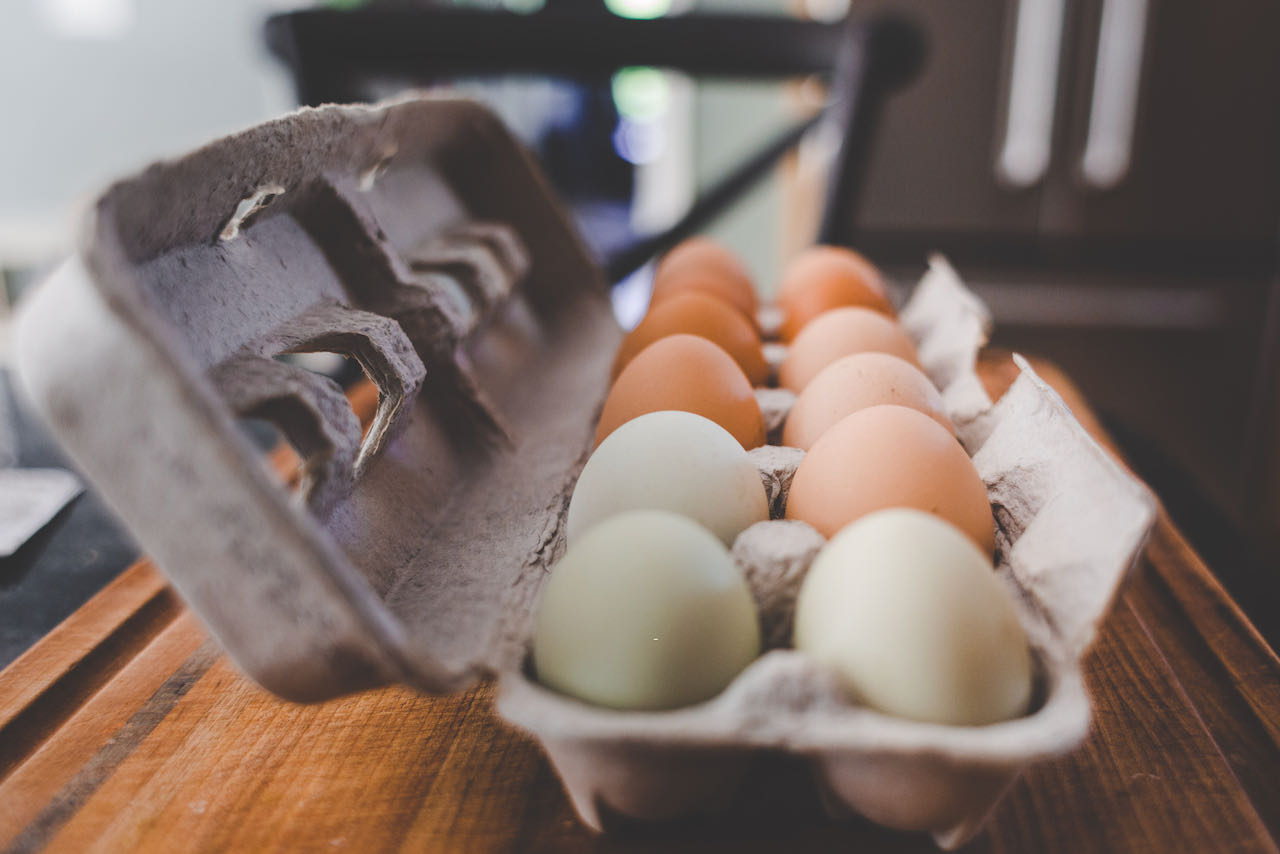
This entry was posted in Chickens
Chickens are fascinating creatures, and their eyes, even more so. Here are some amazing facts about chickens’ eyes that you may not have heard before!
Chickens Can See More Colours Than Us
Chickens are tetrachromatic. They can see the colours we see in (red, yellow and blue), but whilst we have three types of cones in our retinas, chickens have four, which allows them to see in ultraviolet light. This gives chickens access to a much wider range of colours and shades than humans.
Chickens Have a Third Eyelid!
Believe it or not, chickens actually have a third eyelid, on each eye! The third eyelid, called the nictitating membrane, horizontally draws across the eye which helps clean, moisten, and further protect the eyes from dirt. The nictitating membrane is transparent in appearance which means that chickens still have the ability to see, even when the third eyelid is closed.
They Can Use Each Eye Independently
Chickens are able to use each of their eyes independently, with a 300 degree field of vision (humans only have 180!), meaning that both of their eyes can focus on different tasks at the same time. This is also known as monocular vision, which amazingly already begins even before a chick’s arrival. When the chick is still in its shell, it turns towards the right to absorb any light and the left side of the shell is covered by their body. When the chick then hatches, nearsightedness develops in their right eye, which will allow the chick to search for food, as the left simultaneously develops farsightedness. This is to help the chick look out for any potential predators. You will probably notice this from when chickens tilt their heads when a hawk flies over.
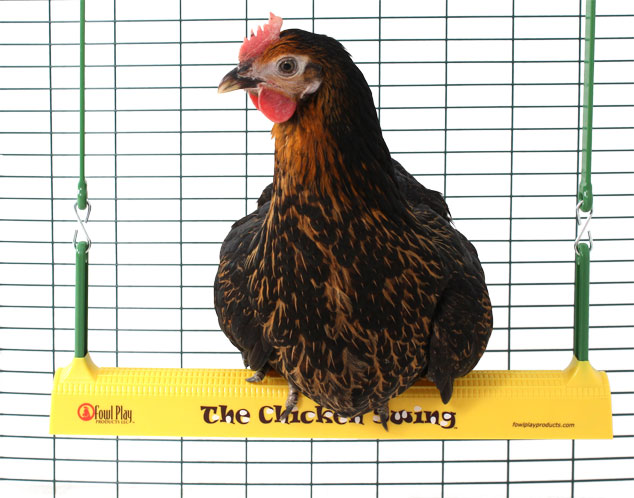
The Omlet Chicken Swing is the perfect toy for keeping chickens entertained!
Chickens Have Terrible Vision in The Dark
Night vision definitely isn’t their strong point! Having descended from dinosaurs all them millions of years ago, as opposed to being preyed on by them like other species, chickens had no need to learn how to run and hide in the dark. For this reason however, chickens today require protection at night because just like humans, they’re awake during the day and sleep during the night, and are highly susceptible to predators.
Chicks Have Amazing Eyesight From Birth
When chicks first hatch, they surprisingly have remarkable eyesight, in fact a lot better than humans. From the minute they hatch, chicks are able to detect small items such as grains of food and even have spatial awareness. A human baby however, lacks this ability and does not develop such skills until a few months down the line.
Chickens Rarely Move Their Eyeballs
Chicken eyes have a very limited range of motion and lack the ability to remain focused on an object whilst the rest of their body is moving. This is why you’ll often see chickens walking around, bobbing their heads, whilst facing onwards. It is not so much a case of chickens not being able to actually move their eyes at all, but rather their eyes cannot move quickly enough to process the image in front of them. Instead, chickens will tend to turn their heads when they want to gain better eyesight of something.
Their Eyes Have a Double Cone Structure
The retina of the eye is composed of rods and cones, the rods being to detect light-sensitive motion, and cones to see colour. As we found out earlier, chickens have more types of cones than us, hence why they are able to enter a fourth dimension of colour, which us humans can’t. A double cone retina structure means that a chicken’s eyes are more sensitive to movement. This is advantageous to chickens as it gives them a greater ability to detect motion, which is helpful when it comes to spotting a perceived threat.
Chicken Eyes Make Up 10% of Their Head Mass
That’s quite a lot, considering our eyes only make up for approximately 1% of our head mass! Although it may look humorous, there’s actually a good reason behind it. Having such large eyes helps chickens to see larger and clearer images as they are produced.
Chickens Can Sense Light Through Their Pineal Gland
Light reaches chickens through either their eyes, skulls, or skin, which activates the pineal gland in the brain. The pineal gland, also sometimes referred to as ‘the third eye’, is something else that makes chicken vision oh so interesting. A pineal gland helps chickens to sense daylight, or the lack of, even if they are unable to see with their eyes. This means that even a blind chicken is able to detect lighting or seasonal change!
They Have the Ability to Recognise up to One Hundred Different Faces
They say that elephants never forget but apparently chickens don’t either! Chickens are able to recognize up to one hundred faces, be it other chickens, humans or any other species. They can also amazingly decipher between their positive and negative encounters.
After a few interesting facts, we’re sure that you’ll now know a whole lot more about the amazing subject of chickens’ eyes, that’ll be bound to get you wondering just what’s really going on through the eyes of your chickens!
This entry was posted in Chickens

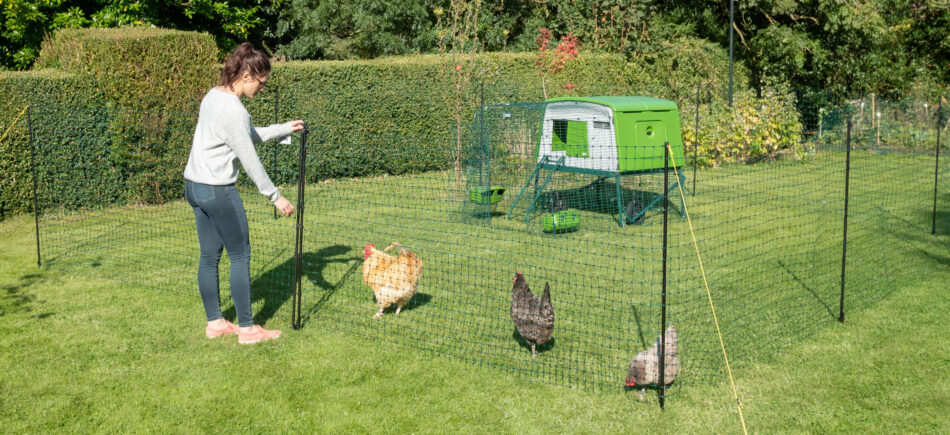
Each year your chickens will experience “moulting”, which is the process of shedding their old feathers and donning new feather skirts. Most hens will slow down their egg production during this time to redirect their energy to the arduous task of growing new feathers. We’ll show you how to help your chickens through a moult, and what to expect throughout the process.
When do chickens moult?
Chickens begin moulting early on in life. In fact, chicks moult frequently during their first few months of life as they shed their baby fluff in favour of their adult feathers. Chicks will moult a total of 4 times:
- First moult within the first 1-6 weeks of age
- Second molt around 7-9 weeks of age
- Third molt around 12-13 weeks of age
- Fourth and final moult around 20-22 weeks of age
By the end of this fourth moult, your chicks’ tail feathers will begin to come in – making cockerels easier to spot.
Once they reach adulthood, all chickens will follow a natural annual moulting cycle that occurs toward the end of summer or the beginning of autumn. The need to grow new feathers will be evident – your hens’ feathers will appear dull or bleached out shortly before they moult. Occasionally, chickens can go through a moulting cycle outside of this timeframe as a response to stress.
How do you know if your chicken is moulting?
While chickens can lose random feathers any time of year due to rough play or preening, minor feather loss is not considered moulting. Molting is accompanied by obvious signs like:
- Patches of missing feathers (some may be large)
- A dishevelled appearance
- Dull combs and wattles
- Irritability
- A sudden drop in egg production
- Increased appetite
The moulting process usually begins with the feathers at the chicken’s head, moving toward the breast and legs, and finally to the tail. By the time the tail is bare, the head feathers will have begun to regrow.
If a chicken is losing feathers and doesn’t grow new ones, you’ll want to do a quick hen health check, as sometimes mites or illness can be to blame for unexplained feather loss. If you suspect an issue other than a seasonal moult, be sure to contact your veterinarian.
What to give chickens to help with moulting
Moulting is not an illness, so while it may not require treatment, your hens will appreciate some extra nutrition during this time. Their taste for protein will increase in response to the extra energy needed to grow new feathers – and they’ll need lots of it.
To add extra protein to the chickens’ diets, give them a feed that is at least 18% protein. If you have a chicken tractor, move your flock to a spot with the most insects. Or, you can use chicken fencing to keep your hens in areas that are dense with bugs for a fresh protein source.
You can also add some apple cider vinegar to your hens’ water, and offer fresh herbs like oregano to give their immune systems a boost. Chicken supplements are an easy way to add nutrients to your flock’s feed, and allowing them to free range as much as possible will help them peck out what their bodies need the most.
What to do when your chickens are moulting
Moulting varies between each hen, but you can expect a full moult to take anywhere from 4-16 weeks to be completed. Try to avoid handling your chickens during this time, and resist covering their bald patches with chicken jackets or clothing. Your hens will be tender and itchy while they’re growing new feathers, so handling them or covering their skin will add unnecessary irritation.
Not all hens will cease egg production for the entire duration of a moult, but it’s normal if they do. It’s normal to expect your hens to stop producing eggs for several weeks while they’re moulting. Flocks will moult together on the same schedule, so be prepared to be short on eggs for a while. Unwashed eggs will keep in the refrigerator for several weeks, so start saving eggs toward the end of summer to head off a temporary egg shortage.
Having an easy-to-clean chicken coop and chicken run are both helpful during a moult – your hens will shed feathers both day and night, leaving feathers everywhere. Dump or rake out shed feathers routinely to keep your flock’s area presentable and to give your hens plenty of dust to bathe in, which will aid in the moulting process.
Keep your flock’s feeders and waterers topped off during their moult, and check on their progress daily. Most hens will go through their cycle without incident or need for human intervention, but keep an eye out for:
- Excessive lethargy from hens
- Bleeding or scabbed over patches
- Difficulty regrowing feathers, or patches of missing feathers even after new ones have grown in
Before you know it, your flock will have ditched their dull, dingy feathers and will emerge dressed in their new, polished plumage just in time for winter.
Molting with Omlet
The annual moulting cycle doesn’t have to be a chore for you and your chickens. Whether you house your hens in our Eglu Cube chicken coop and Walk In chicken run, or one of our chicken tractors, our expertly designed products make it easy for you to help your hens through a moult so that they can get back to feeling, and looking, their best.
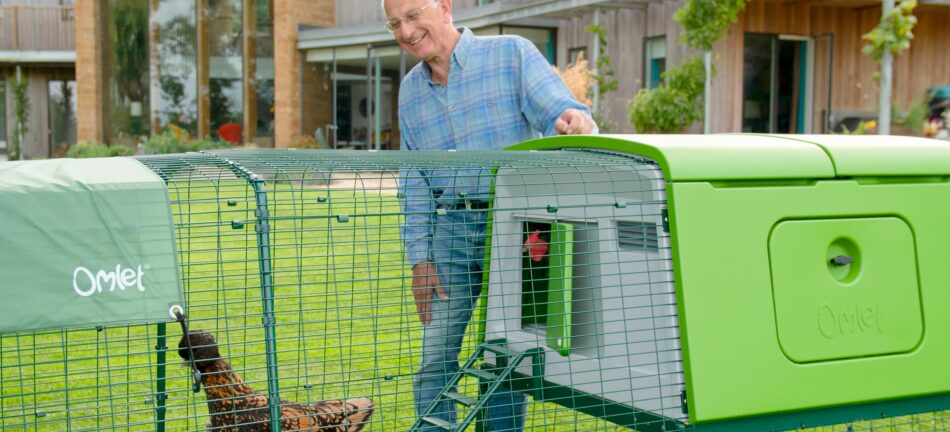
This entry was posted in Chickens
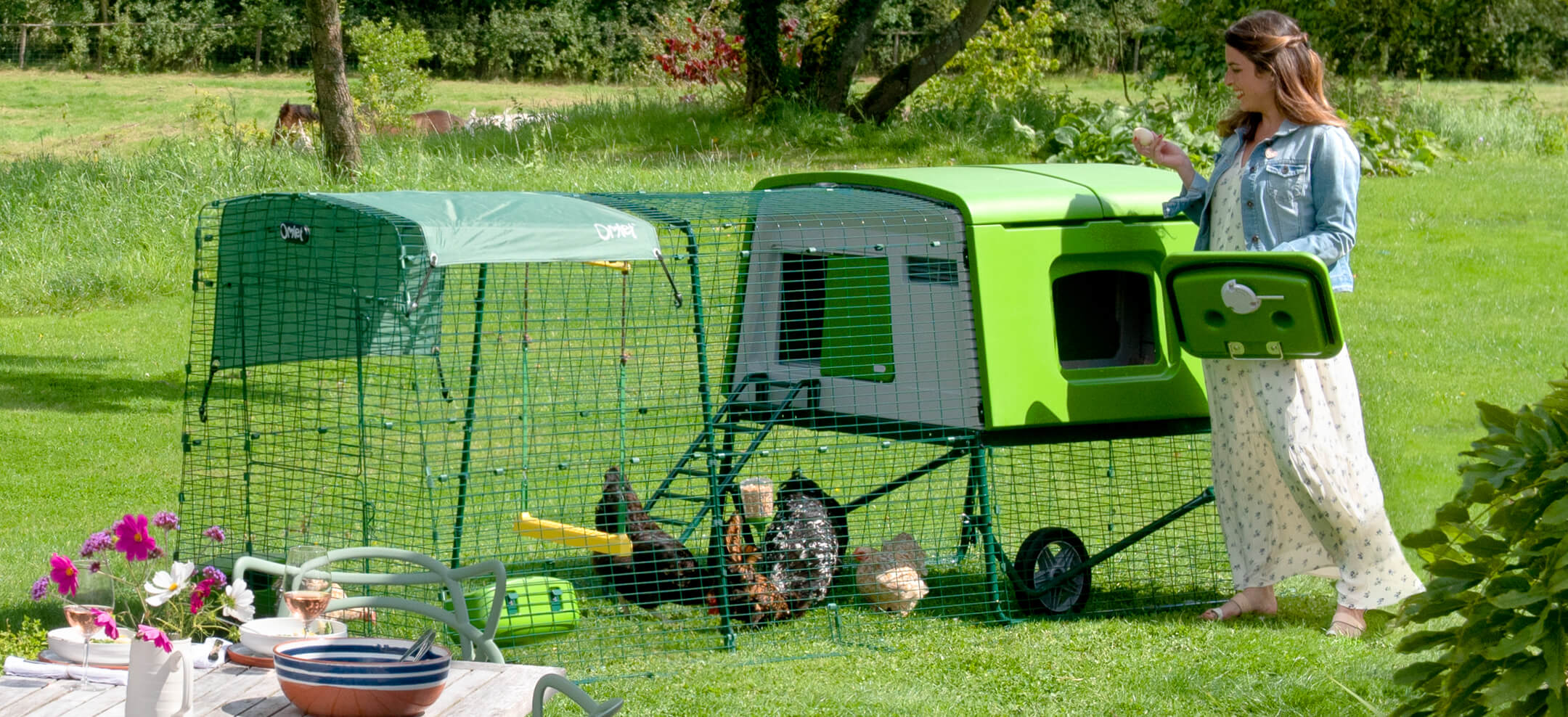
The Eglu Cube Chicken Coop will keep your chickens content all year round!
World’s Heaviest Chicken
The heaviest chicken breed, White Sully, was developed on a farm in California. It’s a hybrid breed of large Rhode Island Reds and other heavy breeds. The largest chicken ever recorded was a rooster called Weirdo, and he weighed just over 10kg (22 lb). It is said that he was so aggressive that he killed two cats during his lifetime and seriously hurt a dog that came too close to his territory.
World’s Oldest Chicken
The current world record holder is Muffy, a Red Quill Muffed American Game hen, who died at the age of 22 in Maryland, USA. One of the more famous old chickens was a Red Pyle chicken called Matilda from Alabama, USA. She was the first hen to receive the title of World’s Oldest Living Chicken from Guinness World Records, and lived for 16 years. Veterinarians said it was likely she lived for so long because she was kept in her owners’ house as a pet, and never laid an egg in her life.
World’s Heaviest Egg
The heaviest egg ever recorded was laid by a White Leghorn chicken in New Jersey, USA in 1956. It weighed 454g (16 oz), and had both a double yolk and a double shell.
World’s Biggest Egg
The heaviest egg was however not the biggest egg ever found. Tony Barbouti in Eastwood, Sussex, once found an egg in his coop measuring 23cm (9.1 in) in circumference. It only weighed just over 161g, but certainly gave Barbouti a shock! He later said that the hen was noticeably shocked after having produced the egg, and she walked a bit funny for a few days, but recovered completely.
World’s Longest Flight
Chickens are not known for their ability to fly. In fact many mean that they can’t technically fly, but only jump high and flap their wings to stay in the air. The longest flight of a chicken that has been recorded is 13 seconds. A different record for the longest distance flown is just under 92m (301 ft). Pretty impressive for a supposedly flightless bird!

World’s Most Prolific Layer
A Prof. Harold V. Bieller conducted experiments with chickens in the late 1970s at the College of Agriculture, University of Missouri. The highest rate of egg-laying he found was by a White Leghorn in 1979. She laid a whopping 371 eggs in 364 days!
World’s Most Prolific Mother Hen
Northern Irish farmer John Dolan has got two hens that have made it into the Guinness Book of Records. His hen Sally entered by having two sets of chicks in just 55 days, the latest of which produced 11 live chicks from 12 eggs. Chickens normally stay with their young for at least three months, but Sally started laying again after only 21 days. John’s other record breaking chicken Marmalade made it into the Book of Records by hatching a remarkable 107 chicks in two years!
This entry was posted in Chickens






 As bizarre as this question may sound, there have been a number of documented cases of chicken keepers claiming that their chickens have changed sex! From the offset, the answer to this question is no – hens most definitely cannot genetically turn into cockerels, nor can cockerels turn into hens.
As bizarre as this question may sound, there have been a number of documented cases of chicken keepers claiming that their chickens have changed sex! From the offset, the answer to this question is no – hens most definitely cannot genetically turn into cockerels, nor can cockerels turn into hens.













 Some Chickens Produce Blue and Pink Eggs!
Some Chickens Produce Blue and Pink Eggs!




 Unfortunately, bullying amongst chickens happens, and isn’t actually too uncommon of a problem. Chickens naturally create a pecking order, whereby the flock will establish themselves in a social hierarchy of strongest to weakest chicken. However, if aggressive behaviour continues after the head rooster, or the dominant hen in their absence, has found their way to the top of the ladder, you may be dealing with a bully. Common signs are missing feathers from a chicken’s back, unusual weight loss, reduced egg production, or blood from where the victim has been pecked, all of which could lead to a chicken/s refusing to go into their coop at night.
Unfortunately, bullying amongst chickens happens, and isn’t actually too uncommon of a problem. Chickens naturally create a pecking order, whereby the flock will establish themselves in a social hierarchy of strongest to weakest chicken. However, if aggressive behaviour continues after the head rooster, or the dominant hen in their absence, has found their way to the top of the ladder, you may be dealing with a bully. Common signs are missing feathers from a chicken’s back, unusual weight loss, reduced egg production, or blood from where the victim has been pecked, all of which could lead to a chicken/s refusing to go into their coop at night. As the days get shorter, you might find that your chickens are not laying as much as they normally do. Egg production is partly regulated by daylight hours, and the more light the chickens see, the more eggs they will lay. Other factors that can affect the production are moulting, broodiness and your hens getting older.
As the days get shorter, you might find that your chickens are not laying as much as they normally do. Egg production is partly regulated by daylight hours, and the more light the chickens see, the more eggs they will lay. Other factors that can affect the production are moulting, broodiness and your hens getting older.  3. Minimise stress
3. Minimise stress








 Chickens sometimes lay eggs that look nothing like a standard supermarket egg. Some are huge, some are tiny, some are ball-shaped, some are pointy, and some are soft-shelled. There are various reasons for these oddities.
Chickens sometimes lay eggs that look nothing like a standard supermarket egg. Some are huge, some are tiny, some are ball-shaped, some are pointy, and some are soft-shelled. There are various reasons for these oddities. Are oddly-shaped chicken eggs a sign of illness?
Are oddly-shaped chicken eggs a sign of illness?
